Contents
Manual 3
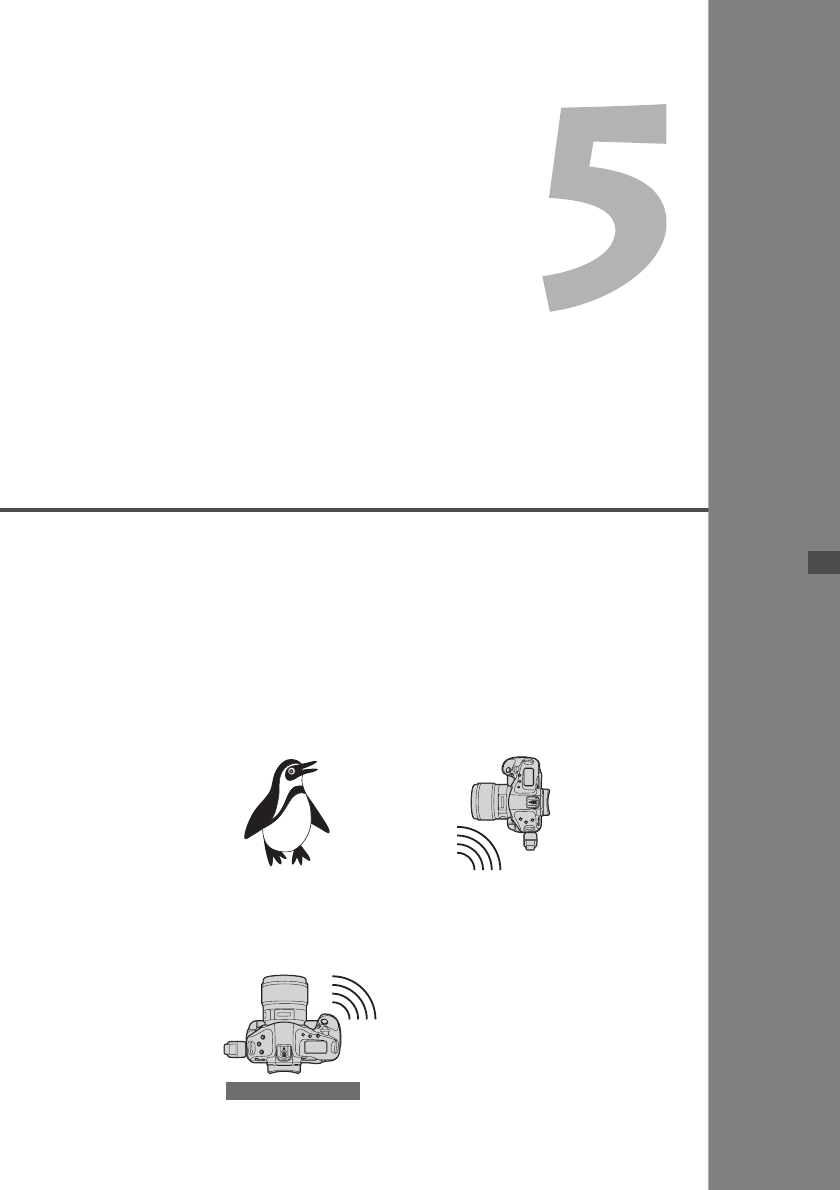
61
Linked Shooting
With linked shooting, up to 10 slave cameras can be linked in a wireless
network (via IEEE 802.11g in ad hoc mode) to the master camera on which
you will release the shutter. Any cameras compatible with linked shooting,
when they have WFT series transmitters attached, can be used as slave
cameras, regardless of model.
Note that there will be a slight delay after you release the master camera
shutter before the slave cameras shoot. Movie shooting is not supported.
Master camera
Slave camera
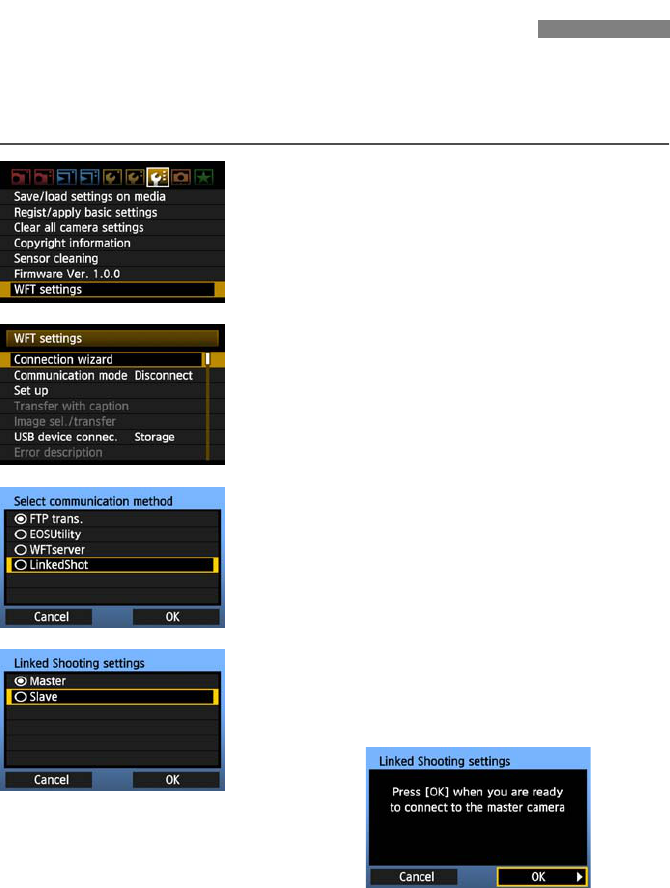
62
First, establish a connection from the slave cameras to the master camera. Because linked
shooting utilizes a wireless connection via IEEE 802.11g in ad hoc mode, it is not available over
wired LANs.
1Display the transmitter menu.
On the camera, press the <7> button.
On the [7] tab, select [WFT settings] and press
<0>. [WFT settings] is added to the tab after
you attach the transmitter.
2Select [Connection wizard].
3Select [LinkedShot].
4Set up the slave cameras.
Select [Slave].
XThe slave cameras are now ready, with the
following screen displayed.
When using multiple slave cameras, set up all
slave cameras to slave state.
Once the settings are complete, slaves cannot be
added or removed. You must repeat the setup
process from step 1.
Setting Up Linked Shooting
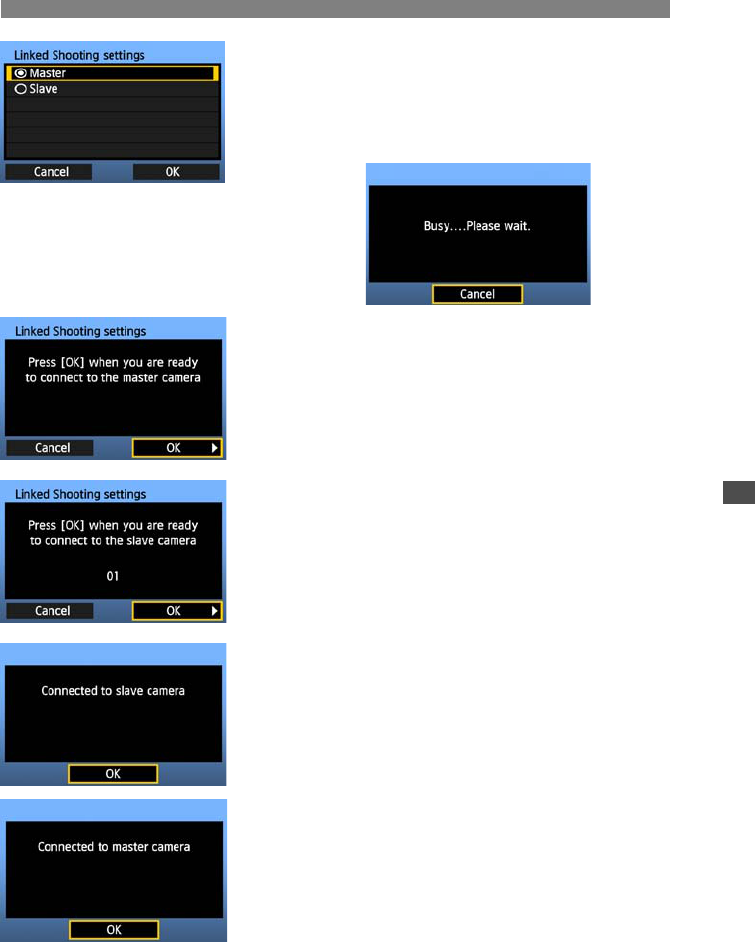
63
Setting Up Linked Shooting
5Set up the master camera.
Configure the settings on the master camera
following steps 1-3 on the previous page, and then
select [Master].
XThe following screen is displayed.
6At this point, switch to setting up the
slave cameras.
On the slave cameras, select [OK].
7Check the number of slave cameras.
XOn the master camera LCD monitor, the number of
slave cameras detected is displayed.
8Establish the connection.
On the master camera and all slave cameras,
select [OK].
XA screen is displayed as the connection is tested.
The information you specified is stored on the
cameras. It is not stored on the transmitters.
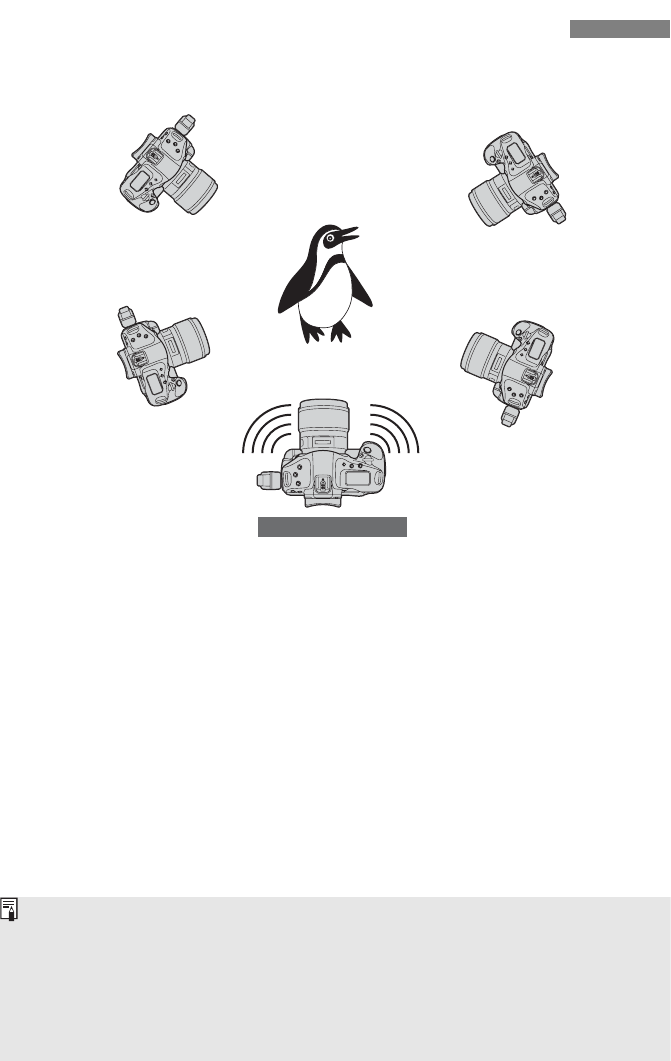
64
Arrange the slave cameras in clear view of the master camera, without objects between
them.
You can arrange master camera in an overall circumference of up to approximately 100 m /
328 ft. However, the distance supported for linked shooting may be shorter depending on
the wireless communication conditions, which are affected by how the cameras are
arranged, the environment of use, and weather conditions.
Pressing the shutter button halfway on the master camera puts slave cameras in the same
state, as if the shutter buttons were pressed halfway. Similarly, fully pressing the shutter
button on the master camera has the same effect on slave cameras, which respond as if the
shutter buttons were fully pressed.
There will be a slight delay after you release the master camera shutter until the slave
camera shutters are released. (Simultaneous capture is not possible.)
Arranging the Slave Cameras
Master camera
Slave camera
Slave cameraSlave camera
Slave camera
During linked shooting, when you press the AE lock or depth-of-field preview button, the camera
focuses and meters as if you had pressed the shutter button halfway.
Once you have established a connection between the master camera and slave cameras, the
settings are retained even after you replace the batteries.
If you will no longer use a slave camera in linked shooting, set [Communication mode] to
[Disconnect] on that slave camera.
Any cameras compatible with linked shooting, when they have WFT series transmitters attached,
can be used as slave cameras, regardless of model.

65
Managing
Settings Information
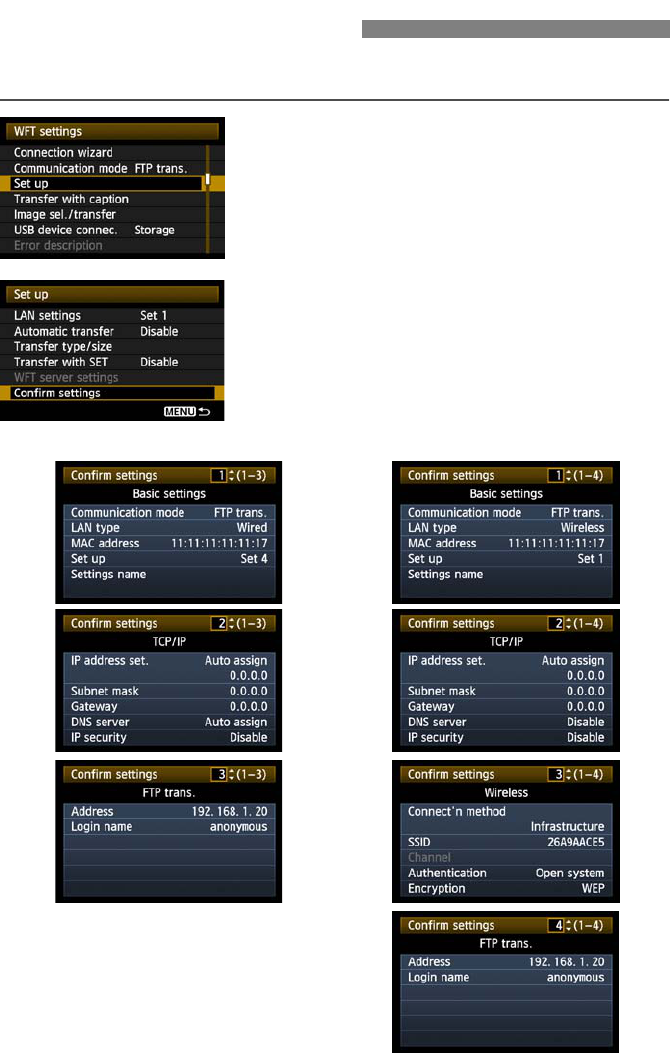
66
Check the network settings as follows.
1In [WFT settings], select [Set up].
2 Select [Confirm settings].
XThe settings are displayed.
Checking Settings
E
xamp
l
e o
f
FTP
t
rans
f
er an
d
w
i
re
d
LAN
se
tti
ngs
E
xamp
l
e o
f
FTP
t
rans
f
er an
d
w
i
re
l
ess
LAN
se
tti
ngs
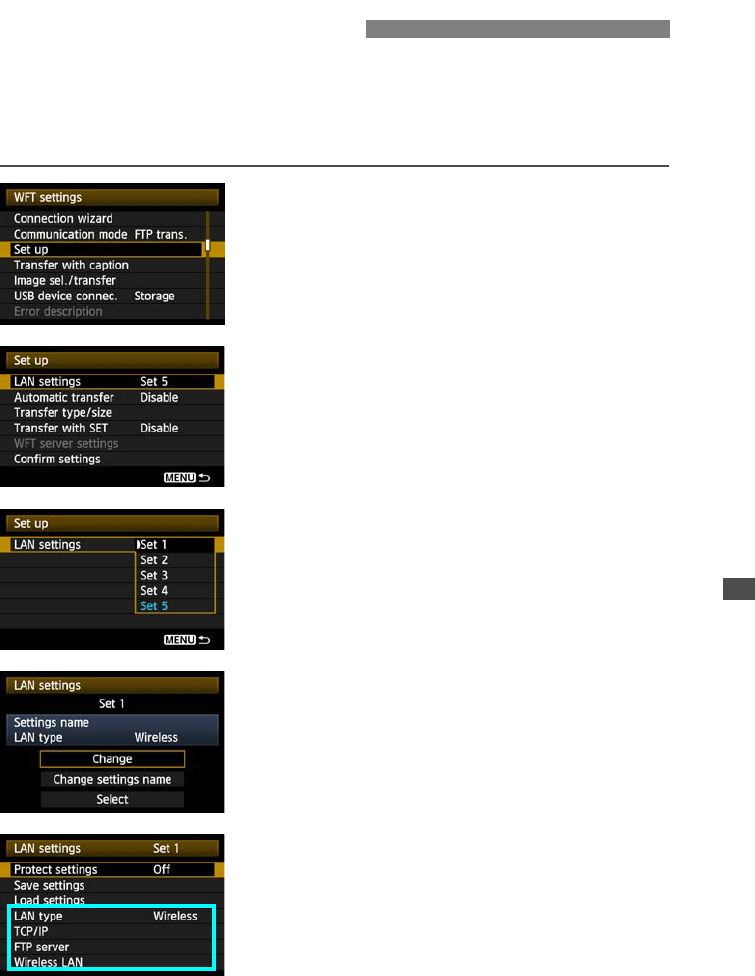
67
Settings originally completed using the connection wizard can be changed as follows. You can
also change IP security settings (IPsec) not completed using the connection wizard, as well as
other settings, such as the setting that determines what happens if an image of the same file
name as an existing file is sent to the FTP server. (p.68)
1In [WFT settings], select [Set up].
2Select [LAN settings].
3Select the settings number.
Here, select the settings number that identifies the
LAN settings.
4Select [Change].
After selecting [Change settings name], you can
rename the settings.
5Select the item to change.
Select the desired item from [LAN type], [TCP/IP],
[FTP server], or [Wireless LAN] and change the
setting.
Changing Settings

68
Changing Settings
Configured in [TCP/IP] [Security].
IPsec is a set of standards for encrypted communication over the Internet. It provides effective
security for both wireless and wired LANs. To use this function, you must enable IPsec in the
network settings of your computer. When IPsec is employed, only transport mode is supported,
and DES encryption and SHA1 authentication are used. Note that the IP address of the
computer for communication with the transmitter must be entered in [Destination address] on
the settings screen.
Configured in [FTP server] [Directory structure].
Selecting [Camera] automatically creates a folder structure matching that of the camera’s (such
as A/DCIM/100EOS1D) in the server’s root folder for image storage. If you have created a
subfolder in the root folder by changing the [Target folder] setting, a folder structure such as A/
DCIM/100EOS1D is automatically created in that folder for image storage.
Selecting [Default] will use the root folder for image storage. If you have created a subfolder in
the root folder by changing the [Target folder] setting, images are saved in that folder.
Configured in [FTP server] [Overwrite same file].
When the transmitter is configured to prevent overwriting
If there is already a file of the same name in the target folder on the FTP server, the new file is
saved with an extension consisting of an underline and a number, as in IMG_0003_1.JPG.
When you resend images if initial transfer fails
Even if the transmitter is configured to overwrite files of the same name, if you resend an image
file that could not be transferred initially, the existing file may not be overwritten in some cases.
If this happens, the new file is saved with an extension consisting of an underline, a letter, and
a number, as in IMG_0003_a1.JPG.
Configured in [FTP server] [Passive mode].
Enable this setting in network environments protected by a firewall. If an Error 41 occurs
(“Cannot connect to FTP server”), setting passive mode to [Enable] may enable access to the
FTP server.
To prevent accidental changes to LAN settings, set [Protect
settings] to [On].
IP Security (IPsec)
Directory Structure of the Target Folder
Overwriting Files of the Same Name
Passive Mode
Preventing Changes to Settings
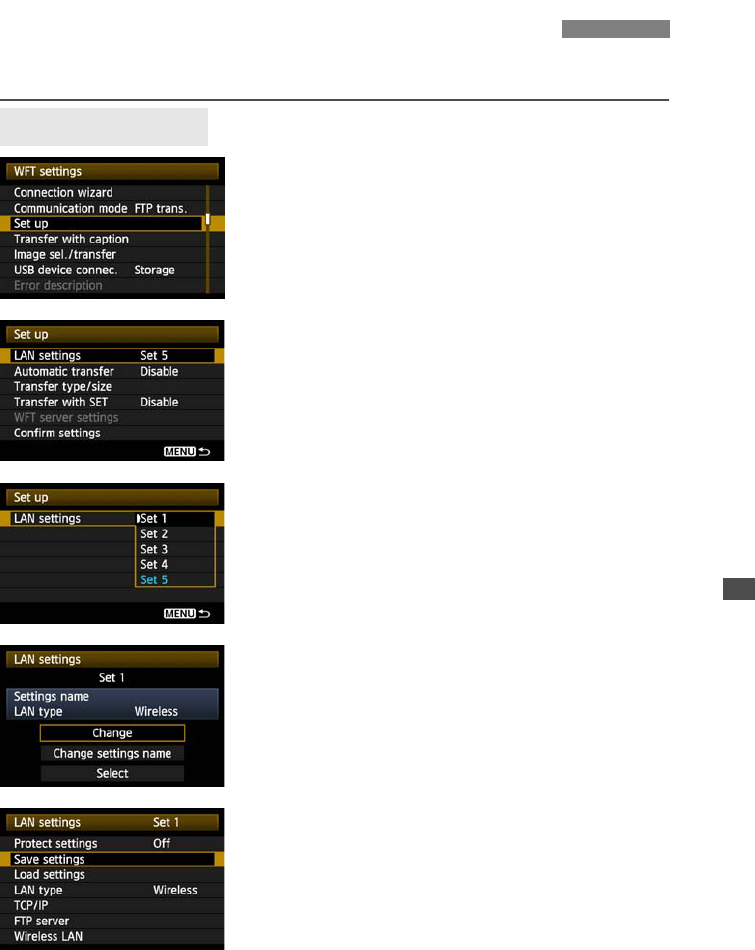
69
Network settings can be saved on a memory card for use with other cameras.
1In [WFT settings], select [Set up].
2Select [LAN settings].
3Select the settings number.
Here, select the settings number that identifies the
LAN settings.
4Select [Change].
5Select [Save settings].
Saving and Loading Settings
Saving Settings
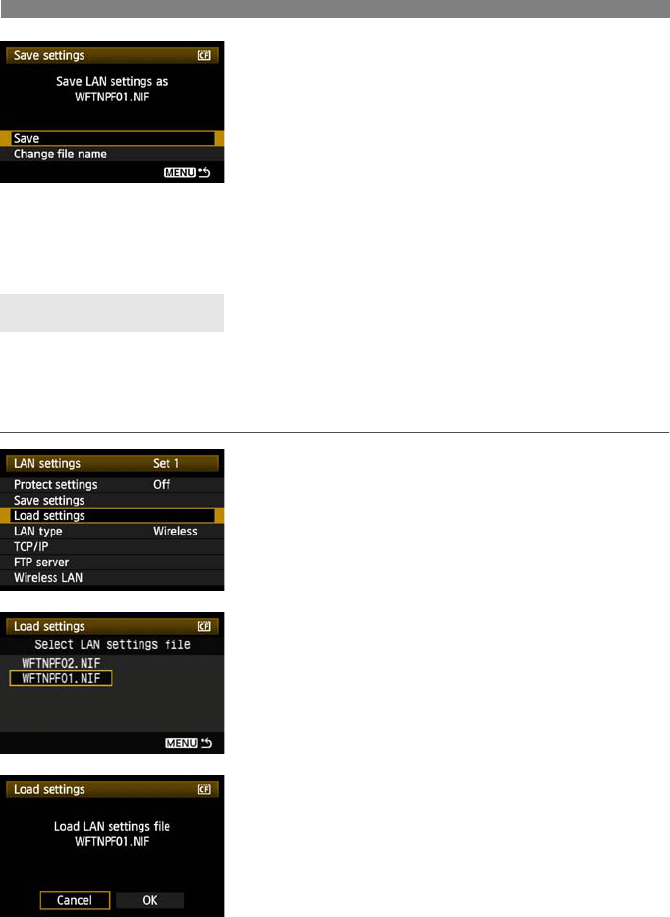
70
Saving and Loading Settings
6Select [Save].
XThe settings are now saved as a file on the
memory card.
The settings are saved as a file (WFTNPF**.NIF)
in the area of the memory card shown when the
card is opened (in the root directory).
The file name is determined automatically by the
camera: WFTNPF, followed by a number (01 to
99) and the extension NIF. You can rename the file
as desired by selecting [Change file name].
Load settings files stored on a memory card as follows. Also use this procedure when loading
settings files created on a computer.
Make sure the settings file is saved in the folder shown when the memory card is opened (that
is, the root directory).
1Select [Load settings].
2Select the settings file.
XSelect a settings file that matches your network
environment.
3Load the settings file.
XInformation from the settings file is loaded into the
selected settings number.
Loading Settings

71
Using External Media
Commercially available external media, connected via USB, can be used
the same way as CF and SD cards. You can also back up images from CF
and SD cards onto external media.
Note that external media must meet the following requirements.
Use media conforming to the USB Mass Storage Class Specification.
If an external hard disk drive is used, use a self-powered drive. Bus-
powered drives do not work in some situations.
The main image storage area must be formatted with a FAT16 or
FAT32 file system.
Use media with a main image storage area of less than 1 TB
(terabyte), with 512 bytes per sector.
Do not use external media equipped with a card slot.
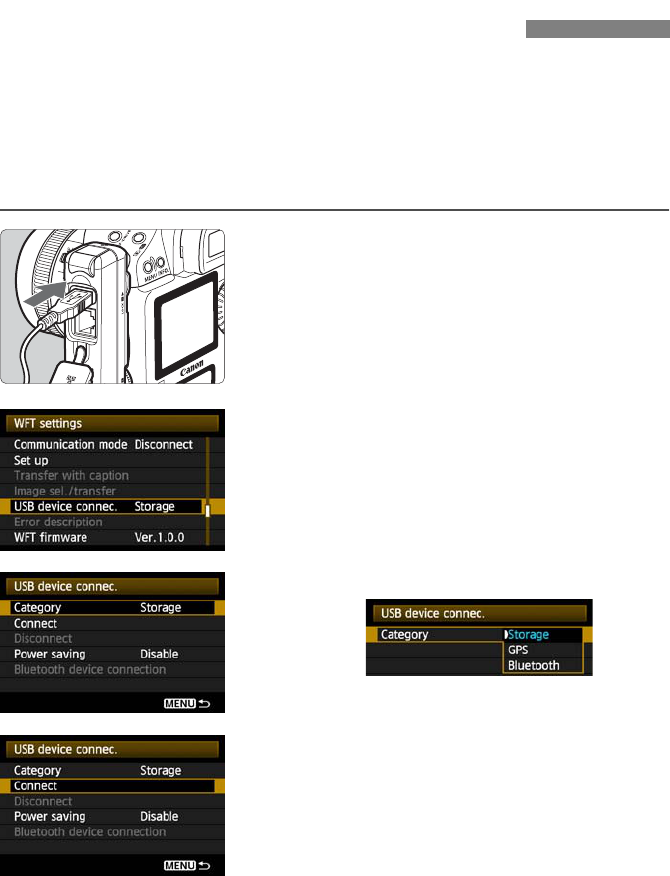
72
Before connecting external media to the transmitter, switch the camera’s power switch to
<
OFF
>. Also turn off external media that has its own power supply.
When connecting external media, be sure to use the USB cable provided with the camera.
The transmitter USB port is not hot-pluggable. USB cables cannot be connected or
disconnected at any time. Follow the instructions in this section when connecting or
disconnecting USB cables.
1Plug the external media into the USB
port.
Open the port cover and connect the external
media.
Do not connect external media via a USB hub.
If the external media is self-powered, turn it on
after connecting it.
2In [WFT settings], select [USB device
connec.].
If you will not use a wireless or wired LAN at the
same time as the external media, set
[Communication mode] to [Disconnect].
3Select [Storage].
4Select [Connect].
Connecting External Media
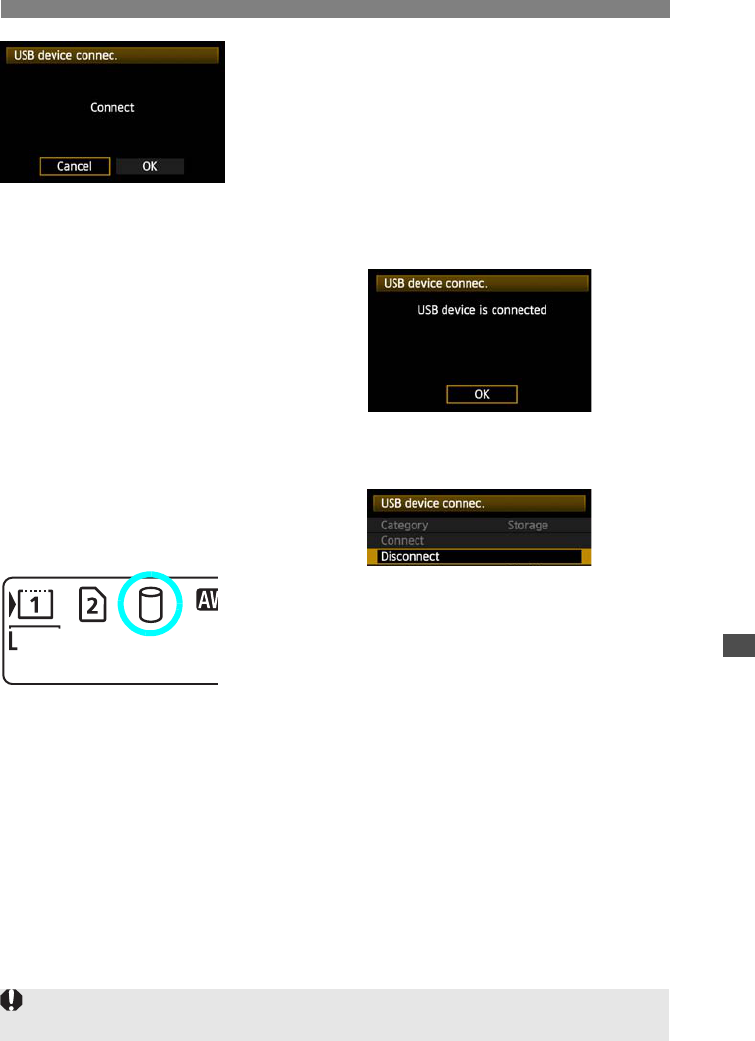
73
Connecting External Media
5Select [OK].
Camera operations such as shooting, menu
display, or image playback are not possible
until the connection is established.
When the transmitter is connected to the external
media, the transmitter’s <
USB
> lamp is lit in green
and a message is displayed indicating that a
connection has been established.
When the confirmation message is displayed,
select [OK].
XAt this point, the menu option [Disconnect]
becomes available. Select this option before
disconnecting the external media.
XAfter you exit the menu, the rear LCD panel
indicates that external media is connected.
External media cannot be formatted using the camera. Format it with a FAT16 or FAT32 file system
using the computer.
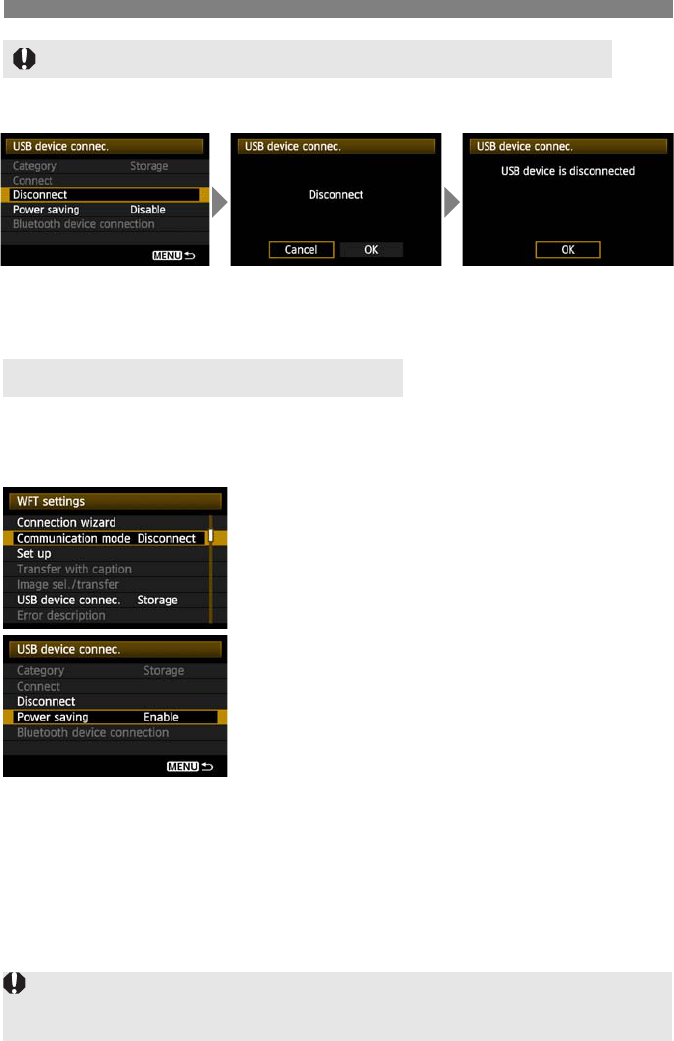
74
Connecting External Media
Before unplugging external media from the USB port, always select [Disconnect] as shown in
step 5. Follow the instructions displayed to terminate the connection.
The connection will not be terminated if you simply turn off the camera and external media. If
you unplug external media while the connection is still active, plug the external media into the
USB port again and follow the preceding steps to terminate the connection.
External media is powered via the transmitter’s USB port as needed. However, external hard
disk drives may not work after connection in some cases.
Power Management
If you will not use a wireless or wired LAN at the
same time as the external media, set
[Communication mode] to [Disconnect]. The
camera battery drains faster under settings other
than [Disconnect] because power saving is
disabled.
Setting [Power saving] to [Enable] enables the
power supply to external media to be stopped
automatically, conserving the camera battery.
Power is supplied again automatically during
shooting, when captured images are stored.
Unplugging External Media from the USB Port
Power Supply to External Media
Before shooting movie, set [Power saving] to [Disable] and make sure the transmitter’s <
USB
> lamp
is lit in green. If you start shooting movie when the <
USB
> lamp is out or blinking, the movie may not be
recorded to external media.
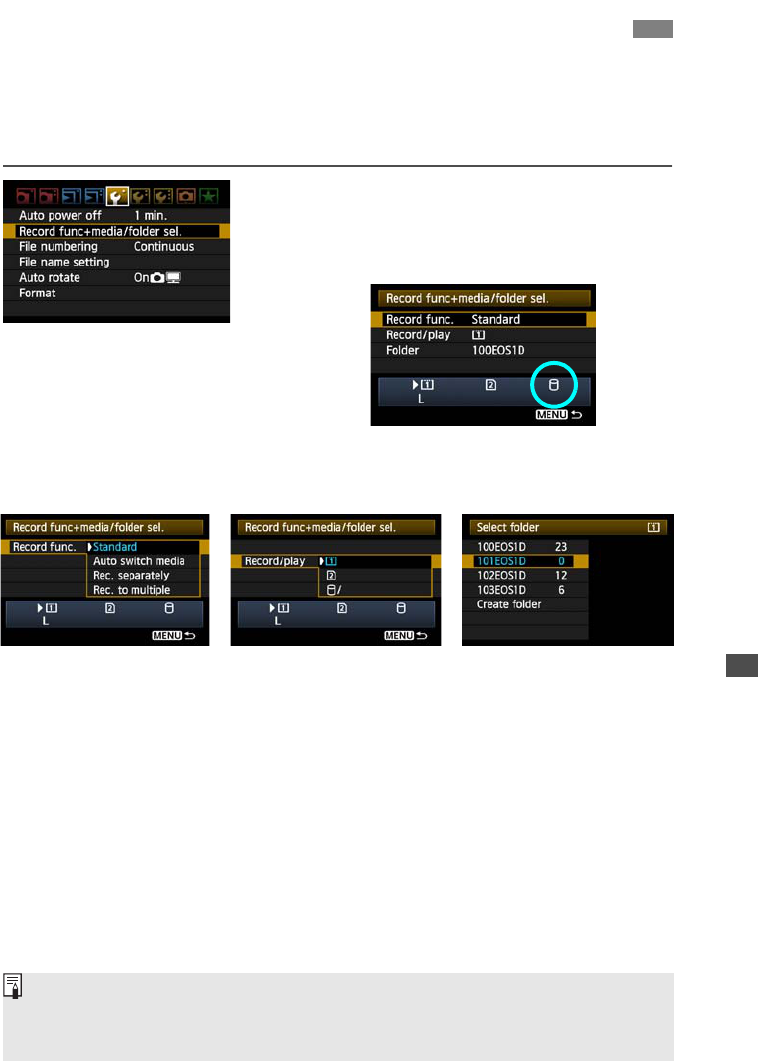
75
Images can be stored on external media connected via USB just as on CF and SD cards.
You can also configure [Record func.], [Record/play], and [Folder] settings (described below)
to use the external media. For details, refer to the Camera Instruction Manual (page 56).
When recording movies to a hard disk, use a hard disk with fast write speeds.
On the [5] tab, select [Record
func+media/folder sel.].
XThe icon for external media is displayed next to
icons for the CF and SD cards.
Complete the following settings, as needed. For
details on using [Record/play] with external
media, refer to the next page.
Choosing Recording Media When Shooting
Although the <
USB
> lamp will blink in green briefly if the camera is restarted or recovering from auto
power off, shooting is still possible. Any images captured at this time are stored temporarily in the
camera's internal memory and then recorded on external media when the <
USB
> lamp remains lit in
green.
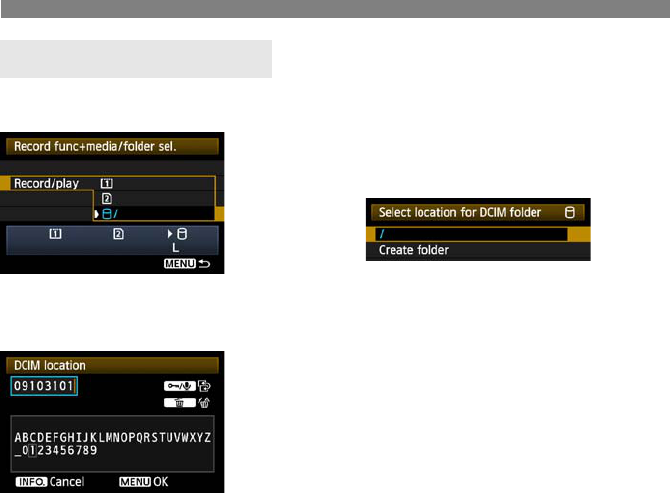
76
Choosing Recording Media When Shooting
When you select external media in [Record/play], the [Select location for DCIM folder]
screen is displayed. The DCIM folder contains the EOS1D folder, where images are stored.
To create the DCIM folder in the first folder
displayed when the external media is opened (that
is, the root directory), select the default setting of [/].
To create another parent folder for the DCIM
folder, select [Create folder]. A screen is
displayed for entering the folder name.
By default, the folder name comprises the current
date (last two digits of the year, in addition to the
month and day) and numbers representing the
order the folder was created, in a range of 01 to
99.
Always use 8 characters for the folder name.
For instructions on entering the folder name, refer to
“Virtual Keyboard Operation” (p.27).
[Record/play] Setting
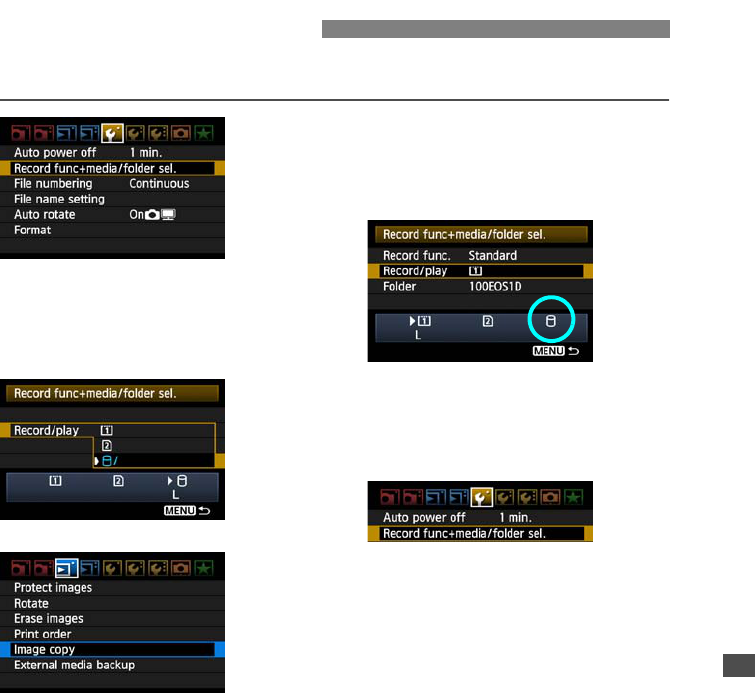
77
Images can be copied to external media connected via USB just as to CF and SD cards.
1On the [5] tab, select [Record
func+media/folder sel.].
XThe icon for external media is displayed next to
icons for the CF and SD cards.
2Select the source media in [Record/
play].
After selection, press the <7> button to return
to the menu screen.
3On the [3] tab, select [Image copy].
For subsequent instructions, refer to the Camera
Instruction Manual (page 176). Operations are the
same as when using a CF or SD card, except that
the external media icon <u> is displayed.
Copying Images
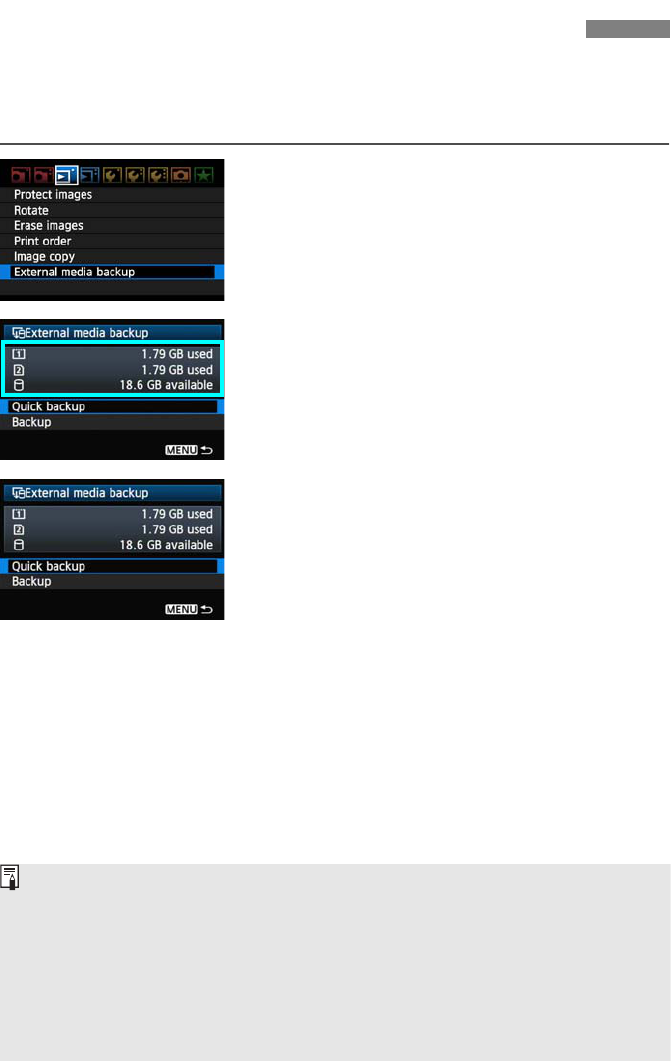
78
Images stored on CF or SD cards can be backed up on external media.
Initially, captured images are stored in the DCIM folder on CF or SD cards. Selecting [External
media backup] backs up this DCIM folder to external media.
1On the [3] tab, select [External media
backup].
2Check the free space on the media.
Make sure more space is available on the external
media than the amount used on the memory card.
If less free space is available on the external
media, backup is not possible.
3Select the method of backup.
Select [Quick backup] or [Backup].
Backing Up on External Media
You can also backup the MISC folder, where printing and transfer instructions are stored.
External media cannot be backed up onto memory cards.
If the backup destination already has a folder of the same number containing images of the same
number, [Skip image and continue], [Replace existing image], and [Cancel backup] are
displayed. Select the backup method and press <0>.
•[Skip image and continue]: All images are backed up except for images of the same number as
existing images
•[Replace existing image]: All images are backed up, including images of the same number as
existing images
Shooting is not possible during backup. Press [Cancel] before shooting.
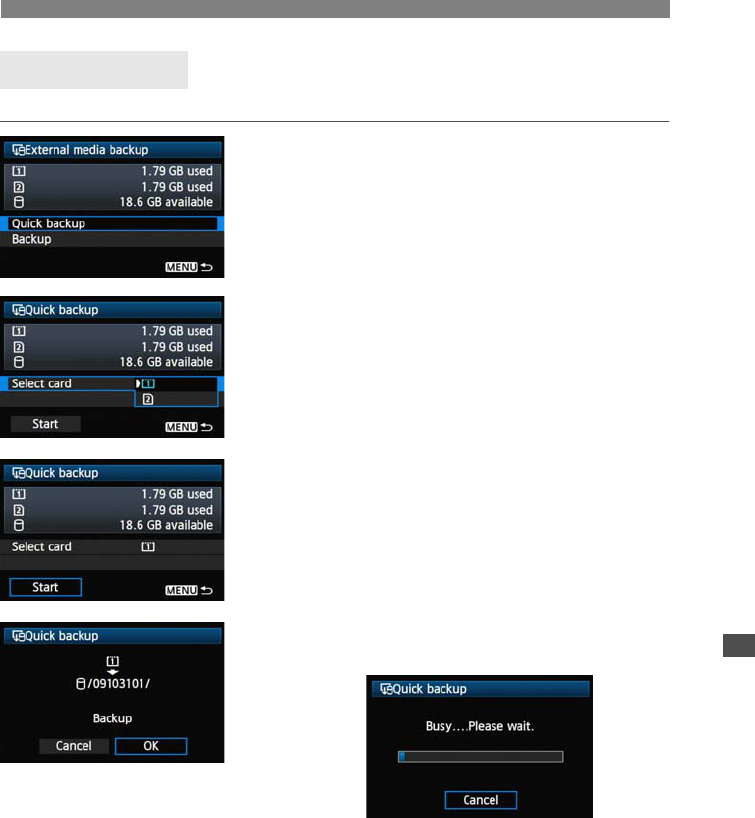
79
Backing Up on External Media
\\\
A simple method of backup is available, as follows.
1Select [Quick backup].
2Select the source memory card.
3Select [Start].
4Select [OK].
XThe backup process now begins.
When the message indicating completion is
displayed, select [OK].
Quick Backup
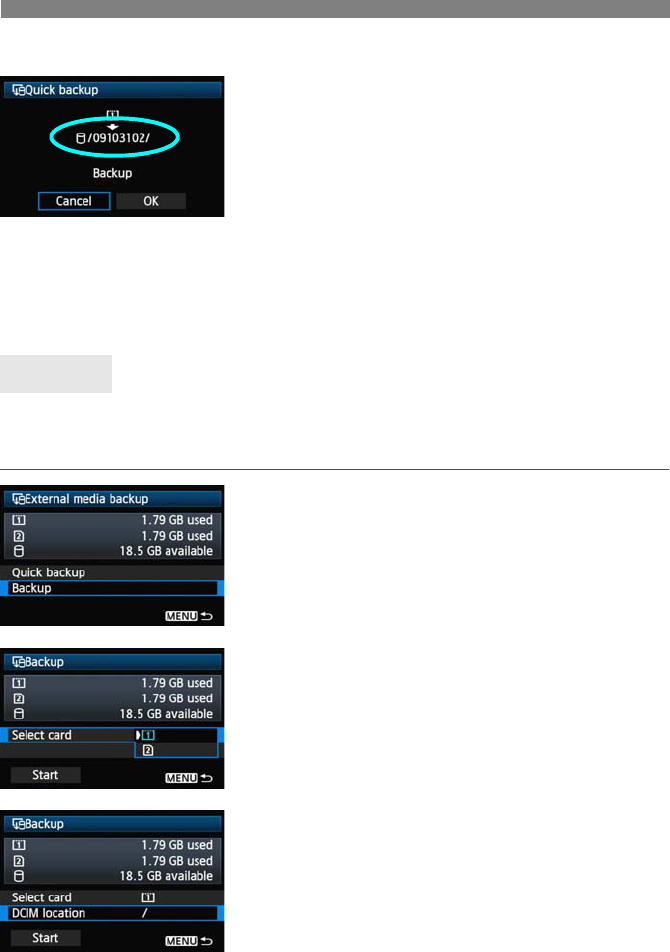
80
Backing Up on External Media
Where the DCIM Folder is Stored
The DCIM folder is stored in a directory indicated
by a file path such as [u/09103102/].
The target folder name comprises the current date
(last two digits of the year, in addition to the month
and day) and numbers representing the order the
folder was created, in a range of 01 to 99.
In the example shown at left, the folder displayed
when the external media is opened (that is, the
root directory) is named 09103102. The DCIM
folder is stored in this folder.
This is also the target folder name displayed when
using the regular [Backup] option.
Select regular [Backup] to create or use a folder of your choice as the parent folder of the
DCIM folder. You can also name this folder as desired. Other functions in this method of backup
are the same as for [Quick backup].
1Select [Backup].
2Select the source memory card.
3Select [DCIM location].
Backup
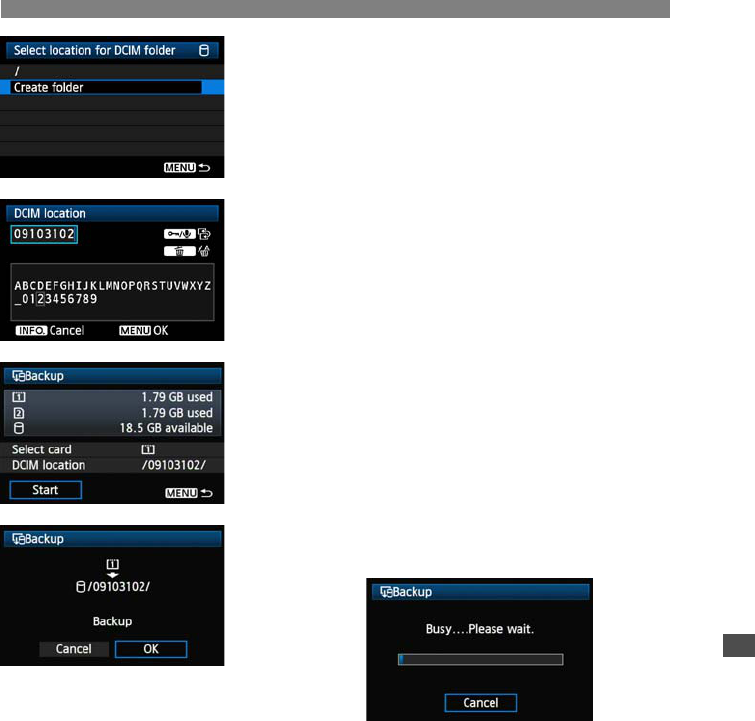
81
Backing Up on External Media
4Select [Create folder].
5Enter the [Folder name].
Always use 8 characters for the folder name.
For instructions on entering the folder name, refer
to “Virtual Keyboard Operation” (p.27).
6Select [Start].
7Select [OK].
XThe backup process now begins.
When the message indicating completion is
displayed, select [OK].

82
Backing Up on External Media
The provided external media case can hold portable hard disks up to 120 x 75 x 15 mm/
4.72 x 2.95 x 0.59 in.
External Media Case

83
Using GPS Devices
Commercially available GPS devices connected via USB can obtain
information including the latitude, longitude, altitude, and date and time of
shooting and add it to images. The additional information can be checked
on the camera as well as by using GPS-compatible mapping software.
The transmitter can be used with Garmin GPSMAP or eTrex series or
Magellan eXplorist series GPS devices that produce data in the format
NMEA 0183 Ver. 3.0.1, as well as some devices that produce Garmin
protocol data (as of November 2009).
For a list of specific GPS devices supported, contact the Canon Service
Center.
For GPS device instructions, refer to the device’s instruction manual or contact the
manufacturer.
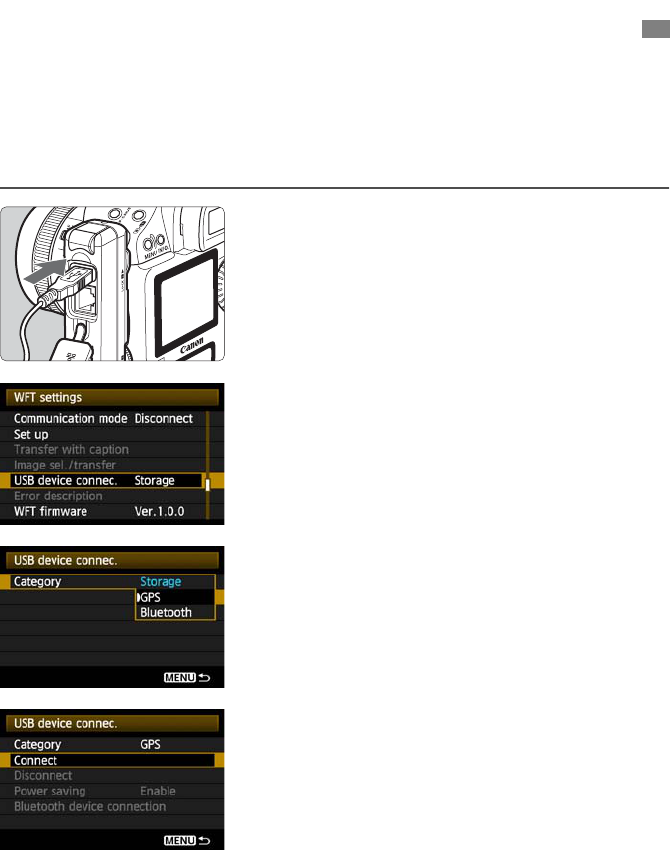
84
Turn off the GPS device and camera before connecting them.
When connecting GPS devices, be sure to use the USB cable provided with the camera.
The transmitter USB port is not hot-pluggable. USB cables cannot be connected or
disconnected at any time. Follow the instructions in this section when connecting or
disconnecting USB cables.
1Plug the GPS device into the USB port.
Open the port cover and connect the GPS device.
Do not connect GPS device via a USB hub.
Do not turn the GPS device on until step 5.
2In [WFT settings], select [USB device
connec.].
If you will not use a wireless or wired LAN at the
same time as the GPS device, set
[Communication mode] to [Disconnect].
3Select [GPS].
4Select [Connect].
Connecting GPS Devices with a USB Cable
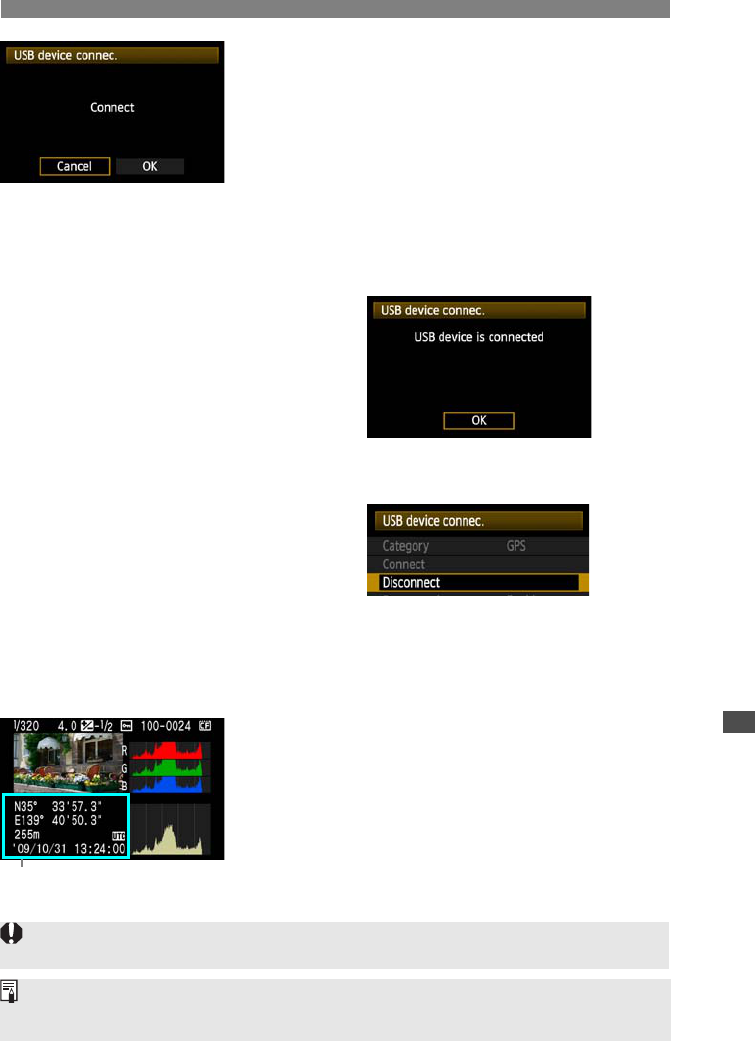
85
Connecting GPS Devices with a USB Cable
5Select [OK].
After selecting [OK], turn the GPS device on.
It may take a few minutes to establish a connection
with the GPS device. Camera operations such as
shooting, menu display, or image playback are
not possible until the connection is established.
When the transmitter is connected to the GPS
device, the transmitter’s <
USB
> lamp is lit in green
and a message is displayed indicating that a
connection has been established.
When the confirmation message is displayed,
select [OK].
XAt this point, the menu option [Disconnect]
becomes available. Select this option before
disconnecting the GPS device.
6Take the picture.
Make sure the transmitter’s <
USB
> lamp is lit in
green before shooting.
If the <
USB
> lamp is not lit in green when you shoot,
correct GPS data will not be added to images.
7Check the GPS data.
View an image.
Press the <6> button to display the shooting
information screen with GPS data.
From top to bottom: latitude, longitude,
altitude, and Coordinated Universal Time
The date and time indicated is the Coordinated Universal Time (UTC) as obtained by the GPS device,
which is nearly the same as Greenwich Mean Time (GMT). In some cases, the date and time of the
zone specified on the GPS device is indicated.
If the camera is turned off and on or recovering from auto power off, do not shoot until the <
USB
> lamp remains
lit in green. If you shoot while the lamp is blinking, the correct GPS information may not be added to images.
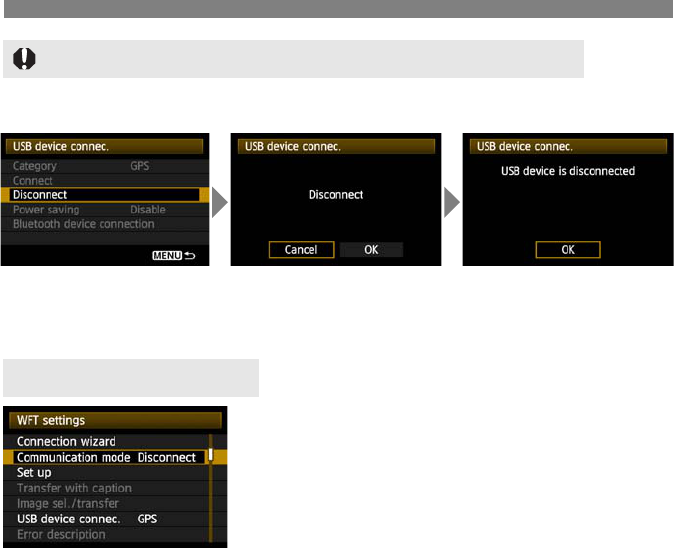
86
Connecting GPS Devices with a USB Cable
Before unplugging GPS devices from the USB port, always select [Disconnect] as shown in
step 5. Follow the instructions displayed to terminate the connection.
The connection will not be terminated if you simply turn off the camera and GPS device. If you
unplug GPS device while the connection is still active, plug the GPS device into the USB port
again and follow the preceding steps to terminate the connection.
If you will not use a wireless or wired LAN at the
same time as the GPS device, set
[Communication mode] to [Disconnect]. The
camera battery drains faster under settings other
than [Disconnect] because power saving is
disabled.
Unplugging GPS Devices from the USB Port
Power Management
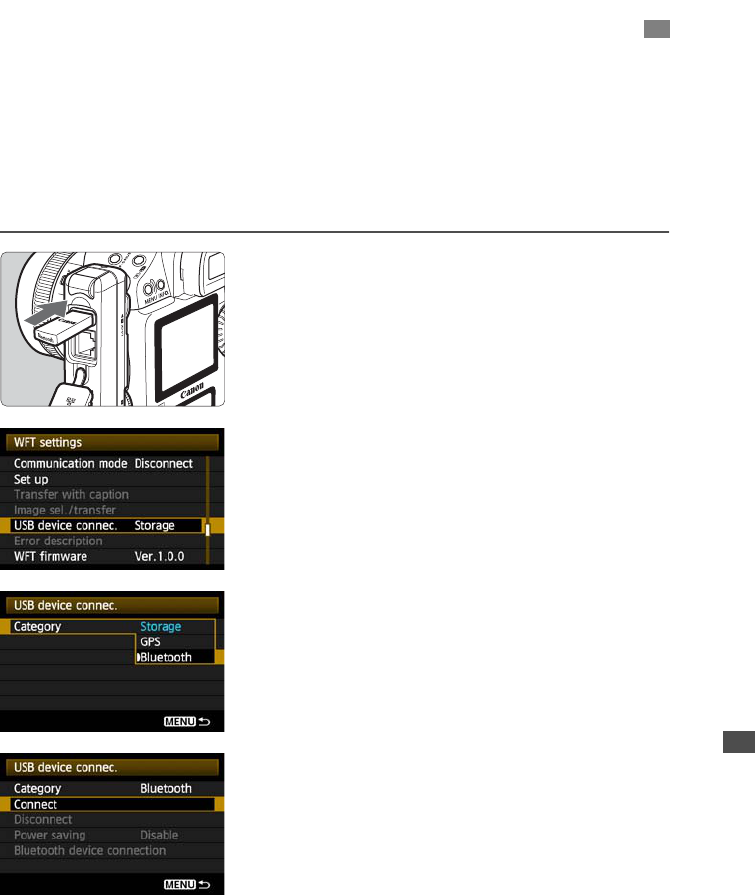
87
By attaching the Canon Bluetooth Unit BU-30 to the USB port, you can connect Bluetooth®
GPS devices wirelessly. (Bluetooth® devices other than GPS devices cannot be connected).
When using non-Canon Bluetooth units, confirm normal operation before use.
Turn off the GPS device and camera before attaching the Bluetooth unit to the transmitter.
The transmitter’s USB port is not hot-pluggable. Bluetooth units cannot be connected or
disconnected indiscriminately. Follow the instructions in this section when attaching or
detaching Bluetooth units.
1Attach the Bluetooth unit.
Open the port cover and attach the Bluetooth unit.
2In [WFT settings], select [USB device
connec.]
If you will not use a wireless or wired LAN at the
same time as the Bluetooth unit, set
[Communication mode] to [Disconnect].
3Select [Bluetooth].
4Select [Connect].
Connecting GPS Devices via Bluetooth
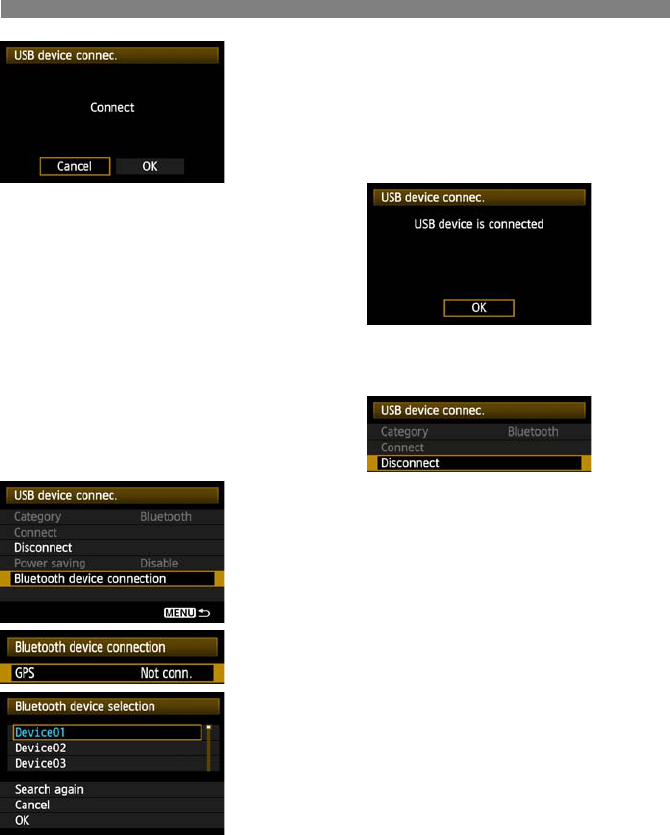
88
Connecting GPS Devices via Bluetooth
5Select [OK].
After the Bluetooth unit is attached to the
transmitter, the transmitter’s <
USB
> lamp blinks in
green and a message is displayed indicating that a
connection has been established.
When the confirmation message is displayed, select [
OK
].
XAt this point, the menu option [Disconnect]
becomes available. Select this option before
detaching the GPS device.
6
Establish a wireless connection between
the GPS device and Bluetooth unit.
Turn on the GPS device and activate Bluetooth® on it.
Select [Bluetooth device connection].
XNearby Bluetooth® devices in use are listed. (Only
GPS devices can be connected.)
7Select the GPS device.
Press <0> to display the connection status of
Bluetooth® devices.
Pressing <
0
> when the status is [
Not conn.
] will
list nearby Bluetooth® devices in use.
Turn the <5> dial to select [GPS] , and then
press <0>.
Select [OK] and press <0>.
If a Bluetooth® password has been set on the
GPS device, a password input screen is displayed.
Enter the password.
XThe transmitter now starts to establish a
connection with the GPS device.
It may take a few minutes to establish a
connection with the GPS device.
Camera operations such as shooting, menu
display, or image playback are not possible
until the connection is established.
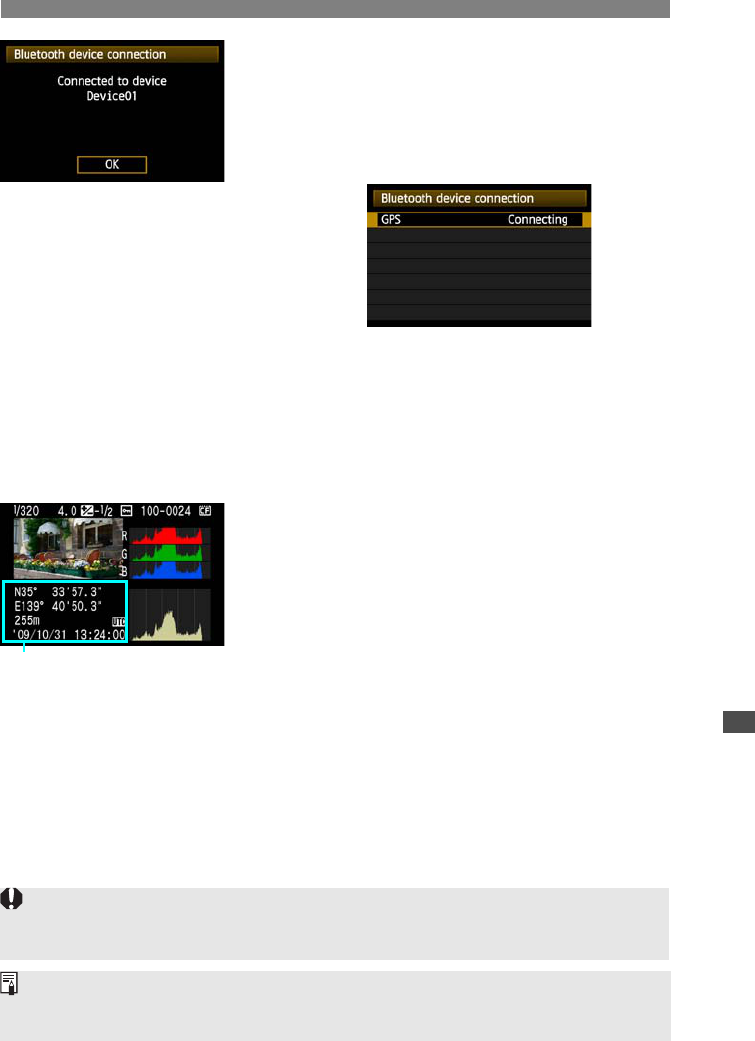
89
Connecting GPS Devices via Bluetooth
8When the confirmation message is
displayed, select [OK].
The GPS connection status changes to
[Connecting]. Pressing <0> under these
conditions will enable you to disconnect the GPS
device.
9Take the picture.
Make sure the transmitter’s <
USB
> lamp is lit in
green before shooting.
If the <
USB
> lamp is not lit in green when you
shoot, the correct GPS data will not be added
to images.
10Check the GPS data.
View an image.
Press the <6> button to display the shooting
information screen with GPS data.
From top to bottom: latitude, longitude,
altitude, and Coordinated Universal Time
If the camera is turned off and on or recovering from auto power off, do not shoot until the <
USB
> lamp
remains lit in green. If you shoot while the lamp is blinking, the correct GPS information may not be
added to images.
The date and time indicated is the Coordinated Universal Time (UTC) as obtained by the GPS device,
which is nearly the same as Greenwich Mean Time (GMT). In some cases, the date and time of the
zone specified on the GPS device is indicated.
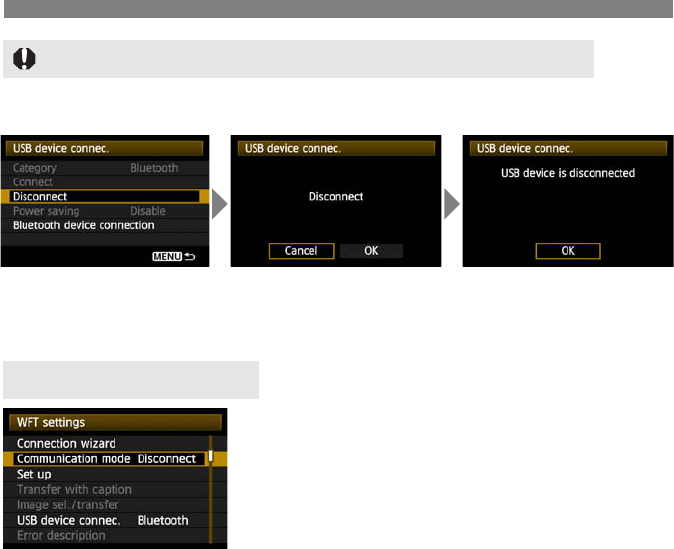
90
Connecting GPS Devices via Bluetooth
Before detaching Bluetooth units from the USB port, always select [Disconnect] as shown in
step 5. Follow the instructions displayed to terminate the connection.
The connection with the Bluetooth unit will not be terminated if you simply turn off the camera. If
you detach a Bluetooth unit while the connection is still active, attach the Bluetooth unit again
and follow the preceding steps to terminate the connection.
If you will not use a wireless or wired LAN at the
same time as the Bluetooth unit, set
[Communication mode] to [Disconnect]. The
camera battery drains faster under settings other
than [Disconnect] because power saving is
disabled.
Detaching Bluetooth units from the USB port
Power Management

91
Troubleshooting
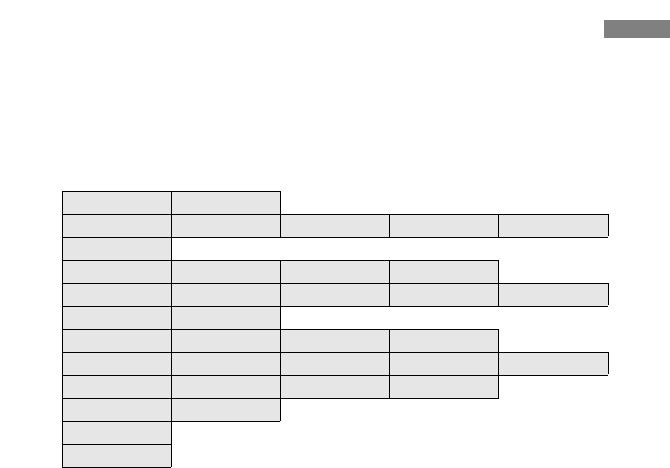
92
If transmitter errors are displayed on the camera LCD monitor, refer to the examples of
corrective actions in this section to eliminate the cause of the error. The error details can also
be checked on the [7] tab [WFT settings] [Error description].
Click the error number in the following chart to jump to the corresponding page.
Responding to Error Messages
11 (p.93) 12 (p.93)
21 (p.93) 22 (p.94) 23 (p.94) 24 (p.95) 25 (p.96)
26 (p.96)
31 (p.97) 32 (p.97) 33 (p.97) 34 (p.97)
41 (p.98) 42 (p.99) 43 (p.99) 44 (p.99) 45 (p.100)
46 (p.100) 47 (p.101)
51 (p.101) 52 (p.101) 53 (p.101) 54 (p.101)
61 (p.102) 62 (p.102) 63 (p.103) 64 (p.103) 65 (p.103)
66 (p.104) 67 (p.104) 68 (p.104) 69 (p.104)
71 (p.105) 72 (p.105)
81 (p.105)
99 (p.105)

93
Responding to Error Messages
Is the pairing software running?
XStart the pairing software and follow the instructions to re-establish the connection. (p.44)
Are the transmitter and wireless LAN terminal configured with the same encryption
key for authentication?
XThis error occurs if the encryption keys do not match when the authentication method for
encryption is [Open system].
The setting is case-sensitive, so check upper- and lower-case characters. Make sure the
correct encryption key for authentication is entered on the transmitter. (p.22)
Are the target computer and wireless LAN terminal on?
XTurn on the target computer and wireless LAN terminal.
What to check on the transmitter
On the transmitter, the network setting is [Auto setting] or the IP address setting is
[Auto assign]. Does the error occur under these settings?
XIf no DHCP server is used, set the transmitter’s network setting to [Manual setting] and
IP address setting to [Manual setting]. (p.25)
What to check on the DHCP server
Is the DHCP server on?
XTurn the DHCP server on.
Are there enough addresses for assignment by the DHCP server?
XIncrease the number of addresses assigned by the DHCP server.
XRemove devices assigned addresses by the DHCP server from the network to reduce the
number of addresses in use.
Is the DHCP server working correctly?
XCheck the DHCP server settings to make sure it is working correctly as a DHCP server.
XIf applicable, ask your network administrator to ensure the DHCP server is available.
11: Connection target not found
12: Connection target not found
21: No address assigned by DHCP server
Responding to Error Messages 21 - 26
Also check the following points when responding to errors numbered 21 - 26.
Are the transmitter and wireless LAN terminal configured with the same encryption key for
authentication?
XThis error occurs if the encryption keys do not match when the authentication method for
encryption is [Open system]. The setting is case-sensitive, so check upper- and lower-case
characters. Make sure the correct encryption key for authentication is entered on the transmitter.
(p.22)

94
Responding to Error Messages
What to check on the transmitter
On the transmitter, the DNS address setting is [Auto assign] or [Manual setting].
Does the error occur under these settings?
XIf no DNS server is used, set the transmitter’s DNS address setting to [Disable]. (p.25)
On the transmitter, does the DNS server’s IP address setting match the server’s
actual address?
XConfigure the IP address on the transmitter to match the actual DNS server address.
(p.25, 107)
What to check on the DNS server
Is the DNS server on?
XTurn the DNS server on.
Are the DNS server settings for IP addresses and the corresponding names
correct?
XOn the DNS server, make sure IP addresses and the corresponding names are entered
correctly.
Is the DNS server working correctly?
XCheck the DNS server settings to make sure the server is working correctly as a DNS
server.
XIf applicable, ask your network administrator to ensure the DNS server is available.
What to check on the network as a whole
Does your network include a router or similar device that serves as a gateway?
XIf applicable, ask your network administrator for the network gateway address and enter it
on the transmitter. (p.25, 107)
XMake sure the gateway address setting is correctly entered on all network devices,
including the transmitter.
What to check on the transmitter
Is another device on the transmitter network using the same IP address as the
transmitter?
XChange the transmitter’s IP address to avoid using the same address as another device
on the network. Otherwise, change the IP address of the device that has a duplicate
address.
XIn network environments with a DHCP server, if the transmitter’s IP address setting is
[Manual setting], change it to [Auto assign]. (p.25)
22: No response from DNS server
23: Duplicate IP address

95
Responding to Error Messages
What to check on the transmitter
The transmitter’s proxy server setting is [Enable]. Does the error occur under this
setting?
XIf no proxy server is used, set the transmitter’s proxy server setting to [Disable]. (p.30)
Do the transmitter’s [Address setting] and [Port No.] settings match those of the
proxy server?
XConfigure the transmitter’s proxy server address and port number to match those of the proxy
server. (p.30)
In the transmitter’s [Proxy server] settings, have you only entered [Server name]?
XIf the proxy server’s [Address] setting is not configured on the transmitter, enter it along
with the DNS server address. (p.25) Make sure the server name and port number for the
proxy server are entered correctly. (p.30)
What to check on the proxy server
Is the proxy server on?
XTurn the proxy server on.
Is the proxy server working correctly?
XCheck the proxy server settings to make sure the server is working correctly as a proxy
server.
XIf applicable, ask your network administrator for the proxy server address or server name
and port number, and then enter them on the transmitter.
What to check on the network as a whole
Does your network include a router or similar device that serves as a gateway?
XIf applicable, ask your network administrator for the network gateway address and enter it
on the transmitter.
XMake sure the gateway address setting is correctly entered on all network devices,
including the transmitter.
24: No response from proxy server

96
Responding to Error Messages
Is another device on the transmitter network using the same IP address as the
transmitter?
XThis error occurs if the transmitter is connected to a network where another device
subsequently connects with the same IP address. Change the transmitter’s IP address to
avoid using the same address as another device on the network. Otherwise, change the
IP address of the device that has a duplicate address.
What to check on the transmitter
On the transmitter, the network setting is [Auto setting]. Does the error occur under
this setting?
XIf no DHCP server is used, set the transmitter’s network setting to [Manual setting].
(p.25)
What to check on the DHCP server
Is the DHCP server on?
XTurn the DHCP server on.
Are the DHCP server settings for IP addresses and the corresponding names
correct?
XOn the DHCP server, make sure IP addresses and the corresponding names are entered
correctly.
Is the DHCP server working correctly?
XCheck the DHCP server settings to make sure it is working correctly as a DHCP server.
XIf applicable, ask your network administrator to ensure the DHCP server is available.
What to check on the network as a whole
Does your network include a router or similar device that serves as a gateway?
XIf applicable, ask your network administrator for the network gateway address and enter it
on the transmitter. (p.25)
XMake sure the gateway address setting is correctly entered on all network devices,
including the transmitter.
25: Another terminal has set the same IP address
26: No response from DHCP server

97
Responding to Error Messages
Has the USB cable been disconnected?
XAfter connecting the USB cable, in [WFT settings], select [USB device connec.] and
reconnect the device.
Is the USB device on?
XTurn the USB device on. Next, also in [WFT settings], select [USB device connec.] and
reconnect the device.
Have you connected a USB device other than external media, a GPS device, or a
Bluetooth unit?
XConnect only external media, GPS devices, or Bluetooth units.
The device is incompatible with the transmitter.
XExternal media with built-in card slots are not compatible. Similarly, USB card readers
cannot be used.
Is the external media formatted with a FAT16 or FAT32 file system?
XFormat the external media with a FAT16 or FAT32 file system using the computer.
The GPS device is incompatible with the transmitter.
XAmong GPS devices, we recommend devices for which operation has been verified by
Canon.
There is a problem with the external media.
XConnect the external media to a computer and confirm that it is working correctly.
Have you connected a USB device other than external media, a GPS device, or a
Bluetooth unit?
XConnect only external media, GPS devices, or Bluetooth units.
31: USB connection disconnected
32: Incompatible USB device
33: USB device error
34: Cannot connect to USB device

98
Responding to Error Messages
What to check on the transmitter
On the transmitter, does the FTP server’s IP address setting match the server’s
actual address?
XConfigure the IP address on the transmitter to match the actual FTP server address.
(p.30)
Are the transmitter and wireless LAN terminal configured with the same encryption
key for authentication?
XThis error occurs if the encryption keys do not match when the authentication method for
encryption is [Open system].
The setting is case-sensitive, so check upper- and lower-case characters. Make sure the
correct encryption key for authentication is entered on the transmitter. (p.22)
On the transmitter, does the [Port number setting] for the FTP server match the
actual port number of the FTP server?
XConfigure the same port number (usually 21) on the transmitter and FTP server.
Configure the port number on the transmitter to match the actual FTP server port number.
(p.30)
If only the FTP server’s [Server name] is configured on the transmitter, are the DNS
server settings complete?
XIf the FTP server’s [Address] setting is not configured on the transmitter, enable use of
the DNS server on the transmitter and enter its address. (p.25) Make sure the FTP server
name is entered correctly. (p.30)
What to check on the FTP server
Is the FTP server working correctly?
XConfigure the computer correctly to function as an FTP server.
XIf applicable, ask your network administrator for the FTP server address and port number,
and then enter them on the transmitter.
Is the FTP server on?
XTurn the FTP server on. The server may have been turned off because of an energy-
saving mode.
On the transmitter, does the FTP server’s IP address setting (in [Address]) match
the server’s actual address?
XConfigure the IP address on the transmitter to match the actual FTP server address.
(p.30)
Is a firewall or other security software enabled?
XSome security software uses a firewall to restrict access to the FTP server. Change the
firewall settings to allow access to the FTP server.
XYou may be able to access the FTP server by setting [Passive mode] to [Enable] on the
transmitter. (p.68)
41: Cannot connect to FTP server

99
Responding to Error Messages
Are you connecting to the FTP server via a broadband router?
XSome broadband routers use a firewall to restrict access to the FTP server. Change the
firewall settings to allow access to the FTP server.
XYou may be able to access the FTP server by setting [Passive mode] to [Enable] on the
transmitter. (p.68)
If you are using Windows XP Service Pack 2 or later, is access to the FTP server
blocked by [Windows Firewall]?
XChange the Windows Firewall settings to allow access to the FTP server.
What to check on the network as a whole
Does your network include a router or similar device that serves as a gateway?
XIf applicable, ask your network administrator for the network gateway address and enter it
on the transmitter. (p.25)
XMake sure the gateway address setting is correctly entered on all network devices,
including the transmitter.
What to check on the FTP server
Is the FTP server configured to restrict access to only some IP addresses?
XChange the FTP server settings to allow access from the [IP address] configured on the
transmitter in the TCP/IP settings.
What to check on the FTP server
Have you exceeded the maximum number of FTP server connections?
XDisconnect some network devices from the FTP server or increase the maximum number
of connections.
This error occurs if the transmitter fails to disconnect from the FTP server for some
reason.
XRestart the FTP server and camera.
42: FTP server rejected connection
43: Cannot connect to FTP server. Error code received from server.
44: Cannot disconnect FTP server. Error code received from server.

100
Responding to Error Messages
What to check on the transmitter
On the transmitter, is the [Login name] entered correctly?
XCheck the logon name for accessing the FTP server. The setting is case-sensitive, so
check upper- and lower-case characters. Make sure the correct logon name is entered on
the transmitter. (p.31)
On the transmitter, is the [Login password] entered correctly?
XIf a logon password is configured on the FTP server, check the upper- and lower-case
characters to make sure the password on the transmitter matches it. (p.31)
What to check on the FTP server
Do the user rights for the FTP server allow reading, writing, and log access?
XConfigure the FTP server’s user rights to allow reading, writing, and log access.
Is the folder specified as the transfer destination on the FTP server named with
ASCII characters (p.27)?
XUse ASCII characters for the folder name.
What to check on the FTP server
The connection was terminated by the FTP server.
XRestart the FTP server.
Do the user rights for the FTP server allow reading, writing, and log access?
XConfigure the FTP server’s user rights to allow reading, writing, and log access.
Do user rights allow access to the target folder on the FTP server?
XConfigure the user rights for access to the target folder on the FTP server to allow saving
images from the transmitter.
Is the FTP server on?
XTurn the FTP server on. The server may have been turned off because of an energy-
saving mode.
Is the hard disk of the FTP server full?
XIncrease available space on the hard disk.
45: Cannot login to FTP server. Error code received from server.
46: For the data session, error code received from FTP server

101
Responding to Error Messages
This error occurs if, for some reason, the transmitter fails to receive confirmation
from the FTP server that image file transfer is complete.
XRestart the FTP server and camera and send the images again.
Is the Bluetooth unit too far from the GPS device?
XBring the GPS device closer to the Bluetooth unit.
Are any obstacles blocking the line of sight between the Bluetooth unit and the
GPS device?
XMove the GPS device to a position visible from the point of view of the Bluetooth unit.
The Bluetooth unit and GPS device were disconnected, for some reason, and the
connection cannot be restored.
XThe connection is more likely to be lost if there are nearby wireless LAN terminals,
cordless telephones, microphones, microwave ovens, or similar devices operating on the
same 2.4 GHz band used for Bluetooth communication. Also note that the connection is
more likely to be lost in poor weather or high humidity.
Is the GPS device on?
XTurn the GPS device on.
Is the GPS device ready for the Bluetooth connection?
XTurn the GPS device on and set it up for connection via Bluetooth.
Is the Bluetooth unit too far from the GPS device?
XBring the GPS device closer to the Bluetooth unit.
Is the GPS device on?
XTurn the GPS device on.
Is the same password set on the Bluetooth unit and GPS device?
XThe setting is case-sensitive, so check upper- and lower-case characters. Make sure the
correct password is entered on the GPS device and Bluetooth unit.
The GPS device does not support SPP (Serial Port Profile).
XConfirm that the GPS device supports SPP.
47: Image file transfer completion not confirmed by FTP server
51: Connection with Bluetooth unit lost
52: Bluetooth unit not found
53: Incorrect Bluetooth password
54: No Bluetooth service

102
Responding to Error Messages
Are any obstacles blocking the line of sight between the transmitter and the
antenna of the wireless LAN terminal?
XMove the antenna to a position clearly visible from the point of view of the transmitter.
(p.106)
What to check on the transmitter
On the transmitter, does the SSID setting match that of the wireless LAN terminal?
XCheck the SSID on the wireless LAN terminal, and configure the same SSID on the
transmitter. (p.21)
What to check on the wireless LAN terminal
Is the wireless LAN terminal on?
XTurn on the wireless LAN terminal.
When you are using WFT-E2 IID with wireless LAN terminals supporting IEEE
802.11a, are the terminal settings locked on IEEE 802.11a?
XConfigure the wireless LAN terminal to allow access via IEEE 802.11b and g.
If you are filtering by MAC address, did you register the transmitter’s MAC address
on the wireless LAN terminal?
XRegister the transmitter’s MAC address (p.66) on the wireless LAN terminal.
What to check on the transmitter
Is the transmitter configured for communication in infrastructure mode?
XConfigure the transmitter for communication in ad hoc mode.
What to check on the wireless LAN terminal
Is there a nearby wireless LAN terminal for ad hoc communication?
XPrepare a wireless LAN terminal for ad hoc communication near the transmitter.
61: Same SSID wireless LAN terminal not found
62: No response from wireless LAN terminal

103
Responding to Error Messages
Are the transmitter and wireless LAN terminal configured for the same
authentication method?
XThe transmitter supports these authentication methods: [Open system], [Shared key],
[WPA-PSK], and [WPA2-PSK]. (p.21)
XWhen using an AirPort for communication in infrastructure mode, [Open system] is not
supported. Configure a [Shared key] on the transmitter. (p.21)
Are the transmitter and wireless LAN terminal configured with the same encryption
key for authentication?
XThe setting is case-sensitive, so check upper- and lower-case characters. Make sure the
correct encryption key for authentication is entered on the transmitter and wireless LAN
terminal. (p.22)
If you are filtering by MAC address, did you register the transmitter’s MAC address
on the wireless LAN terminal?
XRegister the transmitter’s MAC address (p.66) on the wireless LAN terminal.
Are the transmitter and wireless LAN terminal configured for the same encryption
method?
XThe transmitter supports these encryption methods: [WEP], [TKIP], and [AES]. (p.21)
If you are filtering by MAC address, did you register the transmitter’s MAC address
on the wireless LAN terminal?
XRegister the transmitter’s MAC address (p.66) on the wireless LAN terminal.
Are any obstacles blocking the line of sight between the transmitter and the
antenna of the wireless LAN terminal?
XMove the antenna to a position clearly visible from the point of view of the transmitter.
(p.106)
The wireless LAN connection was lost, for some reason, and the connection
cannot be restored.
XThe following are possible reasons: excessive access to the wireless LAN terminal from
other terminals, a microwave oven or similar appliance in use nearby (interfering with
IEEE 802.11b/g reception), poor weather and high humidity. (p.106)
63: Wireless LAN authentication failed
64: Cannot connect to wireless LAN terminal
65: Wireless LAN connection lost

104
Responding to Error Messages
Are the transmitter and wireless LAN terminal configured with the same encryption
key for authentication?
XThe setting is case-sensitive, so check upper- and lower-case characters. Make sure the
correct encryption key for authentication is entered on the transmitter and wireless LAN
terminal. (p.22)
Note that if the authentication method is [Open system], an Error 41 (“Cannot connect to
FTP server”) is displayed.
Are the transmitter and wireless LAN terminal configured for the same encryption
method?
XThe transmitter supports these encryption methods: [WEP], [TKIP], and [AES]. (p.21)
If you are filtering by MAC address, did you register the transmitter’s MAC address
on the wireless LAN terminal?
XRegister the transmitter’s MAC address (p.66) on the wireless LAN terminal.
Have you pressed the Wi-Fi Protected Setup (WPS) button on the wireless LAN
terminal for as long as indicated in the wireless LAN terminal instructions?
XRefer to the instruction manual for the wireless LAN terminal to determine how long to
hold the WPS button.
Are you attempting to establish the connection near the wireless LAN terminal?
XTry establishing the connection when both devices are within reach of each other.
Connection is in progress by other wireless LAN terminals in Pushbutton
Connection mode (PBC mode) of Wi-Fi Protected Setup (WPS).
XWait a while before trying to establish the connection, or try to establish a connection in
PIN code connection mode (PIN mode). (p.24)
66: Incorrect wireless LAN encryption key
67: Incorrect wireless LAN encryption method
68: Cannot connect to wireless LAN terminal. Retry from the
beginning.
69: Multiple wireless LAN terminals have been found. Cannot
connect. Retry from the beginning.

105
Responding to Error Messages
Are you following the correct procedure to establish the connection with slave
cameras?
XOperate slave cameras by following the correct instructions (p.62, 63).
Are the slave cameras too far from the master camera?
XBring the slave cameras closer to the master camera.
Are you following the correct procedure to establish the connection with master
camera?
XOperate the master camera by following the correct instructions (p.62, 63).
Is the master camera too far from the slave cameras?
XBring the master camera closer to the slave cameras.
Is the LAN cable securely connected?
XReconnect the LAN cable between the transmitter and server. Because the cable may be
severed, try using another cable to connect the devices.
Is the hub or router on?
XTurn on the hub or router.
Is the server on?
XTurn the server on. The server may have been turned off because of an energy-saving
mode.
Another problem has occurred, identified with an error number other than 11 to 81.
XTurn the camera’s power switch off and on.
71: Cannot connect to slave cameras
72: Cannot connect to the master camera
81: Wired LAN connection lost
99: Other error

106
When using the transmitter with a wireless LAN, try the following corrective actions if the
transmission rate drops, the connection is lost, or other problems occur.
When using the transmitter indoors, install the wireless LAN terminal in the same room
where you are shooting.
Install the wireless LAN terminal higher than the transmitter.
Install the device where people or objects do not come between it and the camera.
Install the device as close as possible to the camera. In particular, note that during
outdoor use in poor weather, rain may absorb radio waves and disrupt the connection.
If the transmission rate over a wireless LAN drops because of interference from the following
electronic devices, switching to a wired LAN can resolve the problem.
The transmitter communicates over wireless LANs via IEEE 802.11b/g and Bluetooth
using radio waves in the 2.4 GHz band. For this reason, the wireless LAN transmission
rate may drop if there are nearby microwave ovens, cordless telephones, microphones,
or similar devices operating on the same frequency band.
If a wireless LAN terminal on the same frequency band as the transmitter is used nearby,
the transmission rate of the wireless LAN may drop.
If multiple transmitters are connected to a single wireless LAN terminal, be careful not to
use duplicate camera IP addresses.
Note that the transmission rate drops when multiple transmitters access a single wireless
LAN terminal.
To reduce radio wave interference when there are multiple wireless IEEE 802.11b/g
devices, leave a gap of four channels between each wireless LAN channel. For example,
use channels 1, 6, and 11, channels 2, 7, and 12, or channels 3, 8, and 13.
When IEEE 802.11a can be used, switch to IEEE 802.11a and specify a different channel.
Wireless LAN radio waves can be easily intercepted. For this reason, we recommend
activating encrypted communication in the wireless LAN terminal settings.
Wireless LAN Notes
Wireless LAN Terminal Installation and Antenna Position
Nearby Electronic Devices
Using Multiple Transmitters
Security

107
Click the Windows [Start] button [All Programs] [Accessories] [Command Prompt].
Type ipconfig/all and press the <
Enter
> key.
The IP address assigned to the computer is displayed, as well as the subnet mask, gateway,
and DNS server information.
To avoid using the same IP address for the computer and other devices on the network when
configuring the IP address assigned to the camera (page 25), change the rightmost numbers
here.
In Mac OS X, open the [Terminal] application, type ifconfig -a, and press the <
Return
> key.
The IP address assigned to the computer is indicated in the [en0] item by [inet], in the format
***.***.***.***.
To avoid using the same IP address for the computer and other devices on the network when
configuring the IP address assigned to the camera (page 25), change the rightmost numbers
here.
* For information on the [Terminal] application, refer to the Mac OS X help.
Checking Network Settings
Windows
Macintosh
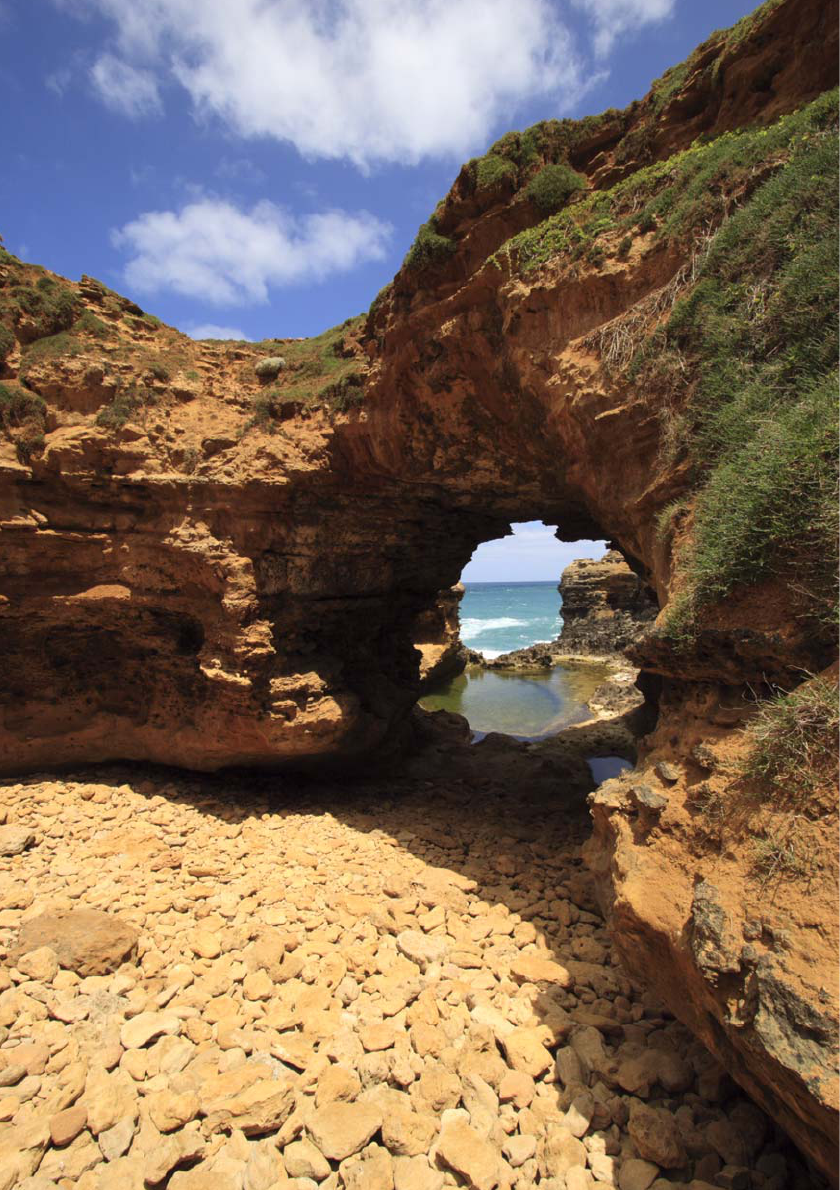
108

109
Reference
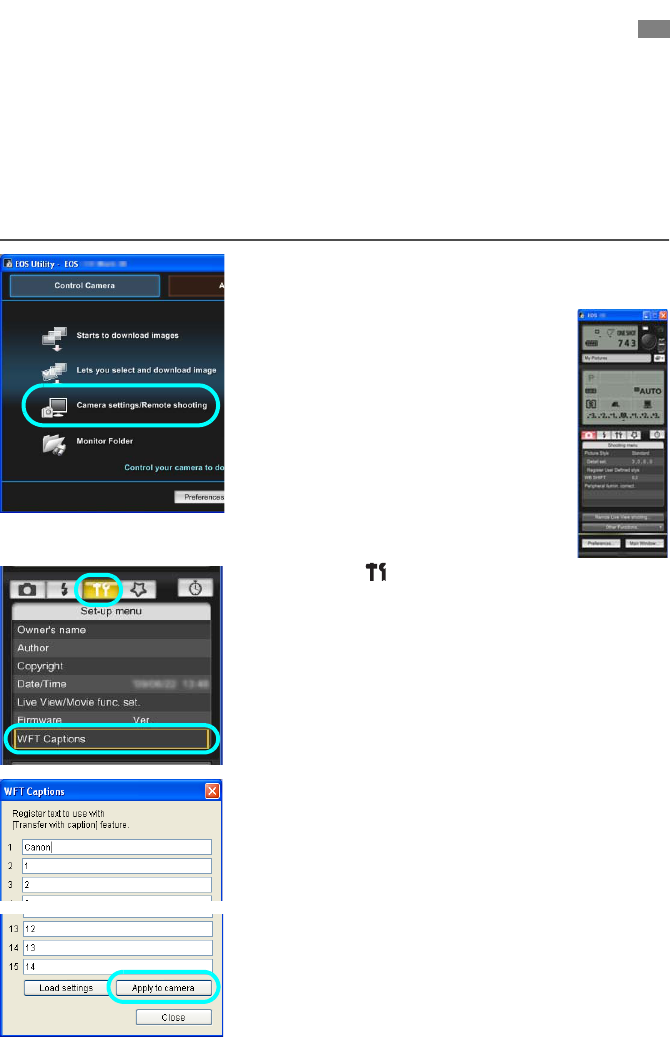
110
Follow these steps to create captions and register them on the camera, as introduced in
“Adding a Caption Before Transfer” (p.35). When creating and registering captions, use a
computer on which EOS Utility is installed.
Before you begin, attach the transmitter to the camera and use the USB cable provided
with the camera to connect the camera to the computer. For instructions on connecting the
camera to the computer with the USB cable and starting EOS Utility, refer to the Software
Instruction Manual (PDF) provided with the camera. Note that captions cannot be created for
cameras without an attached transmitter.
1Start EOS Utility and select [Camera
settings/Remote shooting].
XThe camera settings/remote
capture screen is displayed.
2On the [ ] tab, select [WFT Captions].
XThe screen for caption creation is displayed.
To acquire caption data stored on the camera,
select [Load settings].
3Enter the caption or captions.
Enter up to 31 characters (in ASCII format).
4Register the captions on the camera.
Select [Apply to camera] to register your new
captions on the camera.
Creating and Registering Captions

111
Type
Type: Image transfer accessory that can be used in wireless LANs and over
Ethernet in wired LANs (IPsec-compatible). Can be connected via USB
to external media, GPS devices, and Bluetooth units.
Wireless LAN
Standards compliance: IEEE 802.11a (WFT-E2 IIA/B/C) and ARIB STD-T71
IEEE 802.11b and ARIB STD-T66
IEEE 802.11g and ARIB STD-T66
Transmission method: OFDM modulation (IEEE 802.11a/g)
DS-SS modulation (IEEE 802.11b)
Transmission range: Approx. 150 m / 492 ft.
* With no obstructions between the transmitting and receiving antennas
and no radio interference
* With a large, high-performance antenna attached to the wireless LAN
access point
Transmission frequency: WFT-E2 IIA: 5,180 - 5,320 MHz, channels 36 - 64
(central frequency) 5,745 - 5,825 MHz, channels 149 - 165
2,412 - 2,462 MHz, channels 1 - 11
WFT-E2 IIB: 5,180 - 5,320 MHz, channels 36 - 64
5,500 - 5,700 MHz, channels 100 - 140
2,412 - 2,472 MHz, channels 1 - 13
WFT-E2 IIC: 5,745 - 5,805 MHz, channels 149 - 161
2,412 - 2,472 MHz, channels 1 - 13
WFT-E2 IID: 2,412 - 2,462 MHz, channels 1 - 11
Connection method: Infrastructure or ad hoc mode
* Wi-Fi Protected Setup supported
Security: Authentication method: Open, shared key, WPA-PSK, and WPA2-PSK
Encryption: WEP, TKIP, and AES
Wired LAN
Standards compliance: IEEE 802.3u (Ethernet 10BASE-T and 100BASE-TX)
USB Connection
Connectable devices: External media, GPS devices, and Bluetooth units
Interfaces
Camera: Extension system terminal
Wired LAN: Ethernet RJ-45 port
External device: Hi-Speed USB port (for attaching external media, GPS devices, and
Bluetooth units)
Specifications

112
Specifications
Image Capture Capacity
Approx. number of images
* Using a fully charged LP-E4
* Testing based on Camera & Imaging Products Association (CIPA)
standards
* Fewer images can be captured when transferring images over
wireless LAN.
* Fewer images can be captured when using bus-powered external
media or GPS devices.
Dimensions and Weight
Dimensions (W x H x D): 26.0 x 97.7 x 31.8 mm / 1.0 x 3.8 x 1.3 in.
Weight: Approx. 85 g / 3.0 oz. (Body only)
Operating Environment
Temperature: 0°C - 45°C / 32°F - 113°F
Humidity: 85% or less
All preceding specifications are based on Canon testing standards.
Transmitter specifications and appearance are subject to change without notice
LAN At Normal Temperature
(23°C / 73°F)
At Low Temperature
(0°C / 32°F)
Wireless LAN 1100 900
Wired LAN 1200 900
Model Number
WFT-E2 IIA : DS585802
WFT-E2 IIB : DS585801
WFT-E2 IIC : DS585803
WFT-E2 IID : DS585804
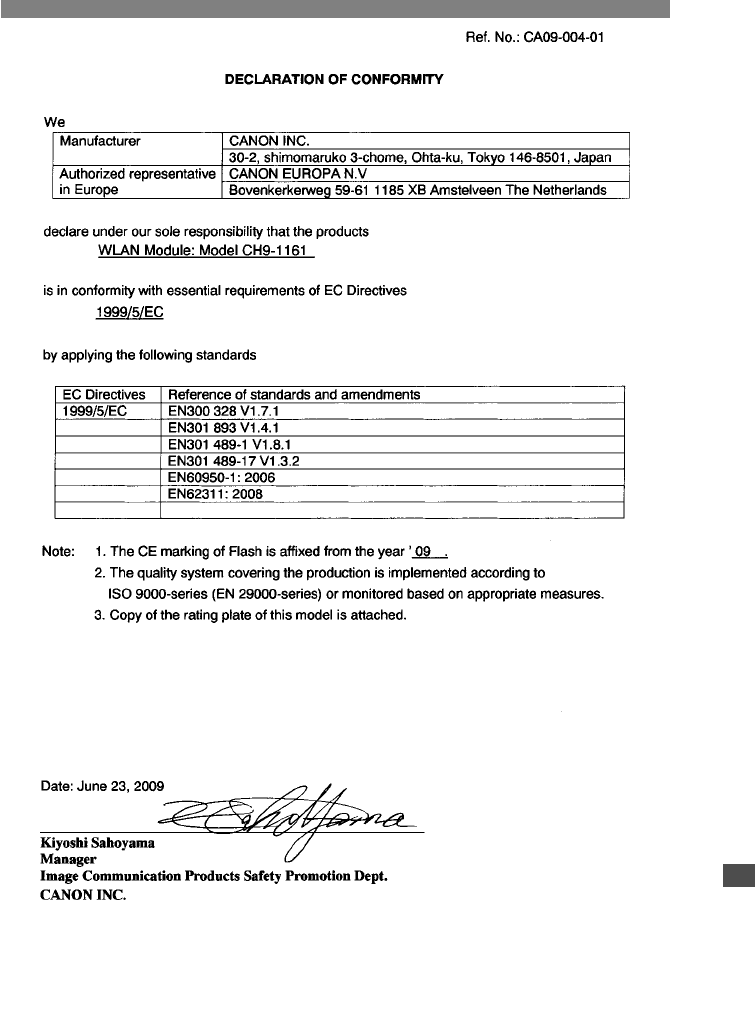
113
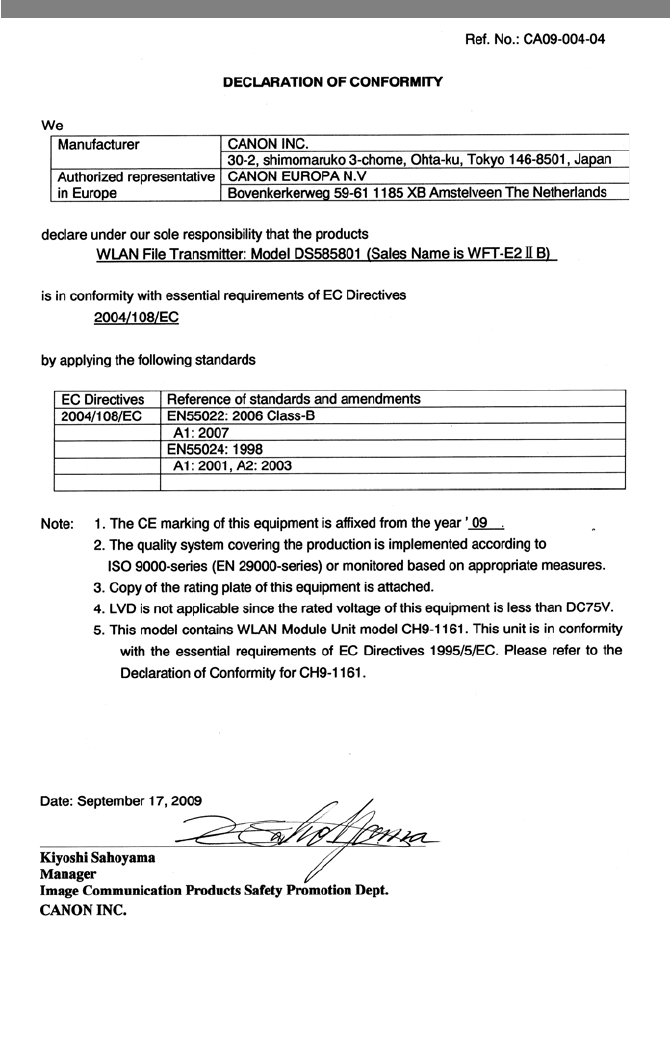
114
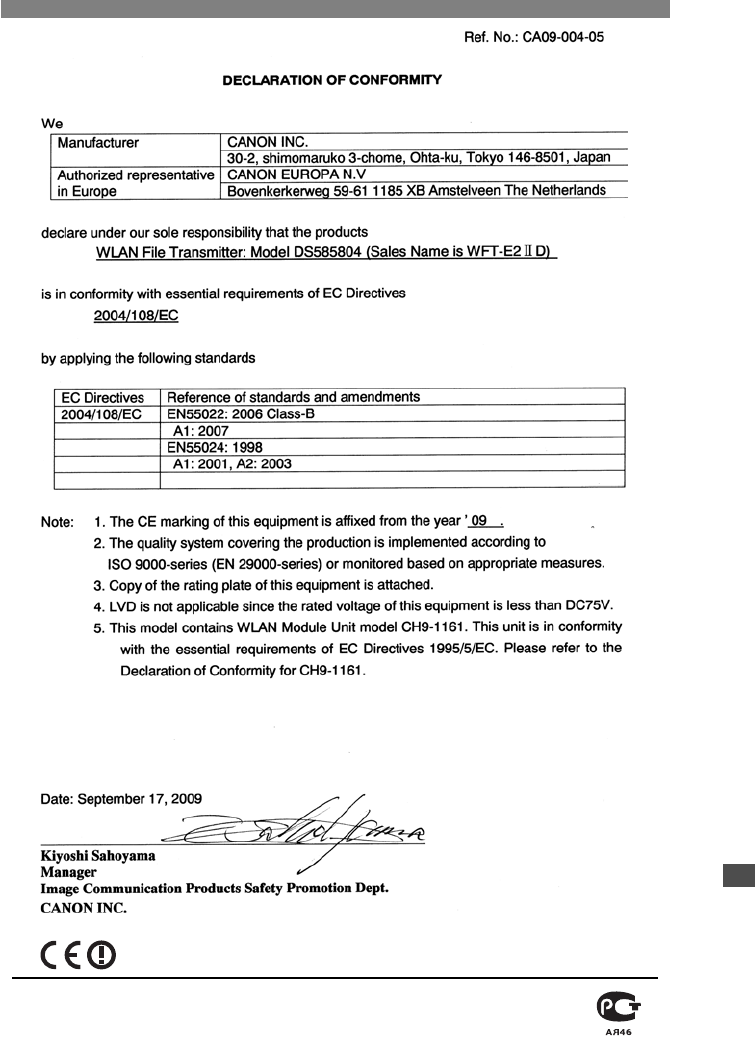
115

116
Statement on EC directive
Canon Inc. tímto prohlašuje, že tento CH9-1161 je ve shodČ se základními požadavky a dalšími pĜíslušnými
ustanoveními smČrnice 1999/5/ES.
Undertegnede Canon Inc. erklærer herved, at følgende udstyr CH9-1161 overholder de væsentlige krav og
øvrige relevante krav i direktiv 1999/5/EF.
Hiermit erklärt Canon Inc., dass sich das Gerät CH9-1161 in Übereinstimmung mit den grundlegenden
Anforderungen und den übrigen einschlägigen Bestimmungen der Richtlinie 1999/5/EG befindet.
Käesolevaga kinnitab Canon Inc. seadme CH9-1161 vastavust direktiivi 1999/5/EÜ põhinõuetele ja
nimetatud direktiivist tulenevatele teistele asjakohastele sätetele.
Hereby, Canon Inc., declares that this CH9-1161 is in compliance with the essential requirements and other
relevant provisions of Directive 1999/5/EC.
Por medio de la presente Canon Inc. declara que el CH9-1161 cumple con los requisitos esenciales y
cualesquiera otras disposiciones aplicables o exigibles de la Directiva 1999/5/CE.
ȂǼ ȉǾȃ ȆǹȇȅȊȈǹ Canon Inc. ¨ǾȁȃǼǿ ȅȉǿ CH9-1161 ȈȊȂȂȅȇĭȃǼȉǹǿ ȆȇȅȈ ȉǿȈ ȅȊȈǿ¨ǼǿȈ
ǹȆǹǿȉǾȈǼǿȈ Ȁǹǿ ȉǿȈ ȁȅǿȆǼȈ ȈȋǼȉǿȀǼȈ ¨ǿǹȉǹȄǼǿȈ ȉǾȈ ȅ¨ǾīǿǹȈ 1999/5/ǼȀ.
Par la présente Canon Inc. déclare que l'appareil CH9-1161 est conforme aux exigences essentielles et aux
autres dispositions pertinentes de la directive 1999/5/CE.
Con la presente Canon Inc. dichiara che questo CH9-1161 è conforme ai requisiti essenziali ed alle altre
disposizioni pertinenti stabilite dalla direttiva 1999/5/CE.
Ar šo Canon Inc. deklarƝ, ka CH9-1161 atbilst DirektƯvas 1999/5/EK bnjtiskajƗm prasƯbƗm un citiem ar to
saistƯtajiem noteikumiem.
Šiuo Canon Inc. deklaruoja, kad šis CH9-1161 atitinka esminius reikalavimus ir kitas 1999/5/EB Direktyvos
nuostatas.
Hierbij verklaart Canon Inc. dat het toestel CH9-1161 in overeenstemming is met de essentiële eisen en de
andere relevante bepalingen van richtlijn 1999/5/EG.
Hawnhekk, Canon Inc., jiddikjara li dan CH9-1161 jikkonforma mal-ƫtiƥijiet essenzjali u ma provvedimenti
oƫrajn relevanti li hemm fid-Dirrettiva 1999/5/EC.
Alulírott, Canon Inc. nyilatkozom, hogy a CH9-1161 megfelel a vonatkozó alapvetõ követelményeknek és az
1999/5/EC irányelv egyéb elõírásainak.
Niniejszym Canon Inc. oĞwiadcza, Īe CH9-1161 jest zgodny z zasadniczymi wymogami oraz pozostaáymi
stosownymi postanowieniami Dyrektywy 1999/5/EC.
Canon Inc. declara que este CH9-1161 está conforme com os requisitos essenciais e outras disposições da
Directiva 1999/5/CE.
Canon Inc. izjavlja, da je ta CH9-1161 v skladu z bistvenimi zahtevami in ostalimi relevantnimi doloþili
direktive 1999/5/ES.
Canon Inc. týmto vyhlasuje, že CH9-1161 spĎĖa základné požiadavky a všetky príslušné ustanovenia
Smernice 1999/5/ES.
Canon Inc. vakuuttaa täten että CH9-1161 tyyppinen laite on direktiivin 1999/5/EY oleellisten vaatimusten ja
sitä koskevien direktiivin muiden ehtojen mukainen.
Härmed intygar Canon Inc. att denna CH9-1161 står I överensstämmelse med de väsentliga egenskapskrav
och övriga relevanta bestämmelser som framgår av direktiv 1999/5/EG.
Hér með lýsir Canon Inc. yfir því að CH9-1161 er í samræmi við grunnkröfur og aðrar kröfur, sem gerðar eru
í tilskipun 1999/5/EC.
Canon Inc. erklærer herved at utstyret CH9-1161 er i samsvar med de grunnleggende krav og øvrige
relevante krav i direktiv 1999/5/EF.
ɋ ɧɚɫɬɨɹɳɢɹ ɞɨɤɭɦɟɧɬ Canon Inc. ɞɟɤɥɚɪɢɪɚ,ɱɟ CH9-1161 ɟ ɜ ɫɴɝɥɚɫɢɟ ɫ ɨɫɧɨɜɧɢɬɟ ɢɡɢɫɤɜɚɧɢɹ ɢ
ɫɴɨɬɜɟɬɧɢɬɟ ɩɨɫɬɚɧɨɜɥɟɧɢɹ ɧɚ Ⱦɢɪɟɤɬɢɜɚ 1999/5/ȿɋ.
Prin prezenta, Canon Inc. declară că acest CH9-1161 este conform cu cerinĠele principale úi cu celelalte
prevederi relevante ale Directivei 1999/5/EC.

117
FCC / IC Notice
Model DS585802/DS585804 (including WLAN Module
Model CH9-1161, FCC ID is 161)
This device complies with Part 15 of FCC Rules and RSS-Gen of IC Rules. Operation is subject
to the following two conditions: (1) this device may not cause interference, and (2) this device
must accept any interference, including interference that may cause undesired operation of this
device.
Note: This equipment has been tested and found to comply with the limits for a Class B digital
device, pursuant to part 15 of the FCC Rules. These limits are designed to provide reasonable
protection against harmful interference in a residential installation.
This equipment generates, uses and can radiate radio frequency energy and, if not installed and
used in accordance with the instructions, may cause harmful interference to radio
communications. However, there is no guarantee that interference will not occur in a particular
installation. If this equipment does cause harmful interference to radio or television reception,
which can be determined by turning the equipment off and on, the user is encouraged to try to
correct the interference by one or more of the following measures:
• Reorient or relocate the receiving antenna
• Increase the separation between the equipment and receiver.
• Connect the equipment into an outlet on a circuit different from that to which the receiver is
connected.
• Consult the dealer or an experienced radio/TV technician for help.
The cable with the ferrite core provided with the digital camera must be used with this equipment
in order to comply with Class B limits in Subpart B of Part 15 of the FCC rules.
Do not make any changes or modifications to the equipment unless otherwise specified in the
manual. If such changes or modifications should be made, you could be required to stop
operation of the equipment.
This transmitter must not be co-located or operated in conjunction with any other antenna or
transmitter.
The available scientific evidence does not show that any health problems are associated with
using low power wireless devices. There is no proof, however, that these low power wireless
devices are absolutely safe. Low power Wireless devices emit low levels of radio frequency
energy (RF) in the microwave range while being used. Whereas high levels of RF can produce
health effects (by heating tissue), exposure to low-level RF that does not produce heating
effects causes no known adverse health effects. Many studies of low-level RF exposures have
not found any biological effects. Some studies have suggested that some biological effects
might occur, but such findings have not been con- firmed by additional research. DS585782/
DS585784 has been tested and found to comply with FCC/IC radiation exposure limits set forth
for an uncontrolled equipment and meets the FCC radio frequency (RF) Exposure Guidelines in
Supplement C to OET65 and RSS-102 of the IC radio frequency (RF) Exposure rules.
Canon U.S.A Inc.
One Canon Plaza, Lake Success, NY 11042, U.S.A.
Tel No. (516)328-5600
This class B digital apparatus complies with Canadian ICES-003.
For body worn operation, this model has been tested and meets the FCC RF exposure
guidelines when used with the CANON INC. Cameras supplied or designated for this product.
Use of other Cameras may not ensure compliance with FCC RF exposure guidelines.
)
DS585802/
DS585804

118
A
Account ..................................................... 50
Ad hoc ................................................... 8, 21
Area of use .................................................. 8
Authentication...................................... 21, 68
Auto power off ........................................... 17
B
Batch transfer ................................ 36, 38, 39
Browser ..................................................... 52
C
Camera control.......................................... 55
Caption ...................................................... 35
Channel ....................................................... 8
Connection ................................................ 17
D
DHCP server ............................................. 25
DNS address ............................................. 25
DNS server................................................ 30
E
Encryption ........................................... 21, 68
Encryption key........................................... 22
EOS Utility ..................................... 13, 43, 47
EOSUtility .................................................. 18
Error .......................................................... 92
ESS-ID ...................................................... 21
F
File of same name..................................... 68
Folder .................................................. 31, 41
FTP server........................................... 13, 29
FTP trans................................................... 18
G
Gateway .................................................... 25
I
IEEE 802.11a .............................................. 8
IEEE 802.11b/g ........................................... 8
Image transfer ..................................... 13, 29
Infrastructure......................................... 8, 21
IP address........................................... 25, 30
IPsec ......................................................... 68
J
JPEG......................................................... 33
K
Key format................................................. 22
Keyboard................................................... 27
L
LAN cable ................................................. 20
Linked shooting......................................... 61
LinkedShot ................................................ 19
Login ......................................................... 31
Logon name .............................................. 50
M
MAC address ............................................ 44
Master camera .......................................... 63
Movie ............................................ 32, 54, 55
N
Network..................................................... 15
O
Open system............................................. 21
P
Pairing................................................. 26, 44
Passive mode ........................................... 68
Password .................................................. 50
PBC mode................................................. 23
PIN code connection mode....................... 24
PIN mode .................................................. 24
Port number .............................................. 30
Protect settings ......................................... 68
Proxy......................................................... 30
Pushbutton connection mode ................... 23
R
RAW.......................................................... 33
RAW+JPEG .............................................. 33
Remote capture .......... 13, 43, 49, 55, 58, 59
Router ....................................................... 25
Wireless and Wired
LAN Functions
Index

119
Index
S
Select folder .............................................. 31
Settings information................................... 65
Shared key ................................................ 21
Simple control............................................ 58
Slave camera ............................................ 62
SSID .......................................................... 21
Stealth functions.................................. 23, 24
Storage...................................................... 41
Subnet mask ............................................. 25
T
Target ........................................................ 31
Target folder .............................................. 68
TKIP .......................................................... 21
Transfer after shooting .............................. 36
Transfer history ......................................... 40
Transfer with SET...................................... 34
Transferred images ................................... 41
Transferring images, automatic................. 32
Transferring images, individual images..... 34
Troubleshooting......................................... 91
U
URL ........................................................... 52
V
Viewing images ......................................... 53
W
Web ........................................................... 52
WEP .......................................................... 21
WFT Server ......................................... 13, 49
WFTserver................................................. 19
Wi-Fi Protected Setup ............................... 23
Wired LAN ................................................. 20
Wireless LAN specification.......................... 8
Wizard ....................................................... 17
WPA2-PSK................................................ 21
WPA-PSK.................................................. 21
WPS (Wi-Fi Protected Setup).............. 23, 24
B
Backing up images .................................... 78
Backup ................................................ 71, 80
Bluetooth................................................... 87
Bus-powered............................................. 71
C
Copying images ........................................ 77
E
Error .......................................................... 92
External media .............................. 13, 71, 75
G
GPS .......................................................... 83
GPS data .................................................. 85
GPS device ............................................... 13
H
Hard disk................................................... 71
M
Media ........................................................ 71
P
Power........................................................ 74
Power management............................ 74, 86
Q
Quick backup ............................................ 79
R
Replace existing image............................. 78
S
Self-powered............................................. 71
Skip image and continue........................... 78
T
Troubleshooting ........................................ 91
U
USB connection ........................................ 71
Functions When
Connected via USB

CANON INC. 30-2, Shimomaruko 3-chome, Ohta-ku, Tokyo 146-8501, Japan
U.S.A. CANON U.S.A. INC.
One Canon Plaza, Lake Success, NY 11042-1198, U.S.A.
For all inquires concerning this product, call toll free in the U.S.
1-800-OK-CANON
CANADA CANON CANADA INC. HEADQUARTERS
6390 Dixie Road, Mississauga, Ontario L5T 1P7, Canada
CANON CANADA INC. MONTREAL BRANCH
5990, Côte-de-Liesse, Montréal Québec H4T 1V7, Canada
CANON CANADA INC. CALGARY OFFICE
2828, 16th Street, N.E. Calgary, Alberta T2E 7K7, Canada
For all inquiries concerning this product, call toll free in Canada
1-800-OK-CANON
EUROPE, CANON EUROPA N.V.
AFRICA & Bovenkerkerweg 59-61, 1185 XB Amstelveen, The Netherlands
MIDDLE EAST CANON FRANCE S.A.S.
17,Quai du Président Paul Doumer, 92414 Courbevoie Cedex, France
CANON UK LTD.
Woodhatch Reigate, Surrey RH2 8BF, United Kingdom
CANON DEUTSCHLAND GmbH
Europark Fichtenhain A10, 47807 Krefeld, Germany
CANON ITALIA S.p.A.
Via Milano 8, 20097 San Donato Milanese, (MI), Italy
CANON Schweiz A.G.
Industriestrasse 12, 8305 Dietlikon, Switzerland
Canon GmbH
Zetschegasse 11, A-1230 Vienna, Austria
CANON España,S.A.
Av. De Europa,6 Alcobendas 28108 Madrid, Spain
CANON Portugal S.A.
Rua Alfredo da Silva,14 Alfragide 2610-016 Amadora, Portugal
CENTRAL & CANON LATIN AMERICA, INC.
SOUTH AMERICA 703 Waterford Way, Suite 400 Miami, FL 33126, U.S.A.
ASIA CANON (China) Co., LTD
15F Jinbao Building No.89 Jinbao Street, Dongcheng District, Beijing 100005, China
CANON HONGKONG CO., LTD.
19/F., The Metropolis Tower, 10 Metropolis Drive, Hunghom, Kowloon, Hong Kong
CANON SINGAPORE PTE. LTD.
1 HarbourFront Avenue, #04-01 Keppel Bay Tower, Singapore 098632
CANON KOREA CONSUMER IMAGING INC.
Gangnam Finance Center 17F, 737,Yeoksam-Dong, Gangnam-Gu, Seoul, 135-984, Korea
OCEANIA CANON AUSTRALIA PTY. LTD.
1 Thomas Holt Drive, North Ryde, Sydney N.S.W. 2113, Australia
CANON NEW ZEALAND LTD.
Akoranga Business Park, Akoranga Drive, Northcote, Auckland, New Zealand
JAPAN CANON MARKETING JAPAN INC.
16-6, Kohnan 2-chome, Minato-ku, Tokyo 108-8011, Japan
CT1-7835aE-000 © CANON INC. 2009
This instruction manual is current as of November 2009. For information on using the transmitter
with accessories introduced after this date, contact your nearest Canon Service Center.